60 Stylish Terrace Ideas to Elevate Your Outdoor Living Space
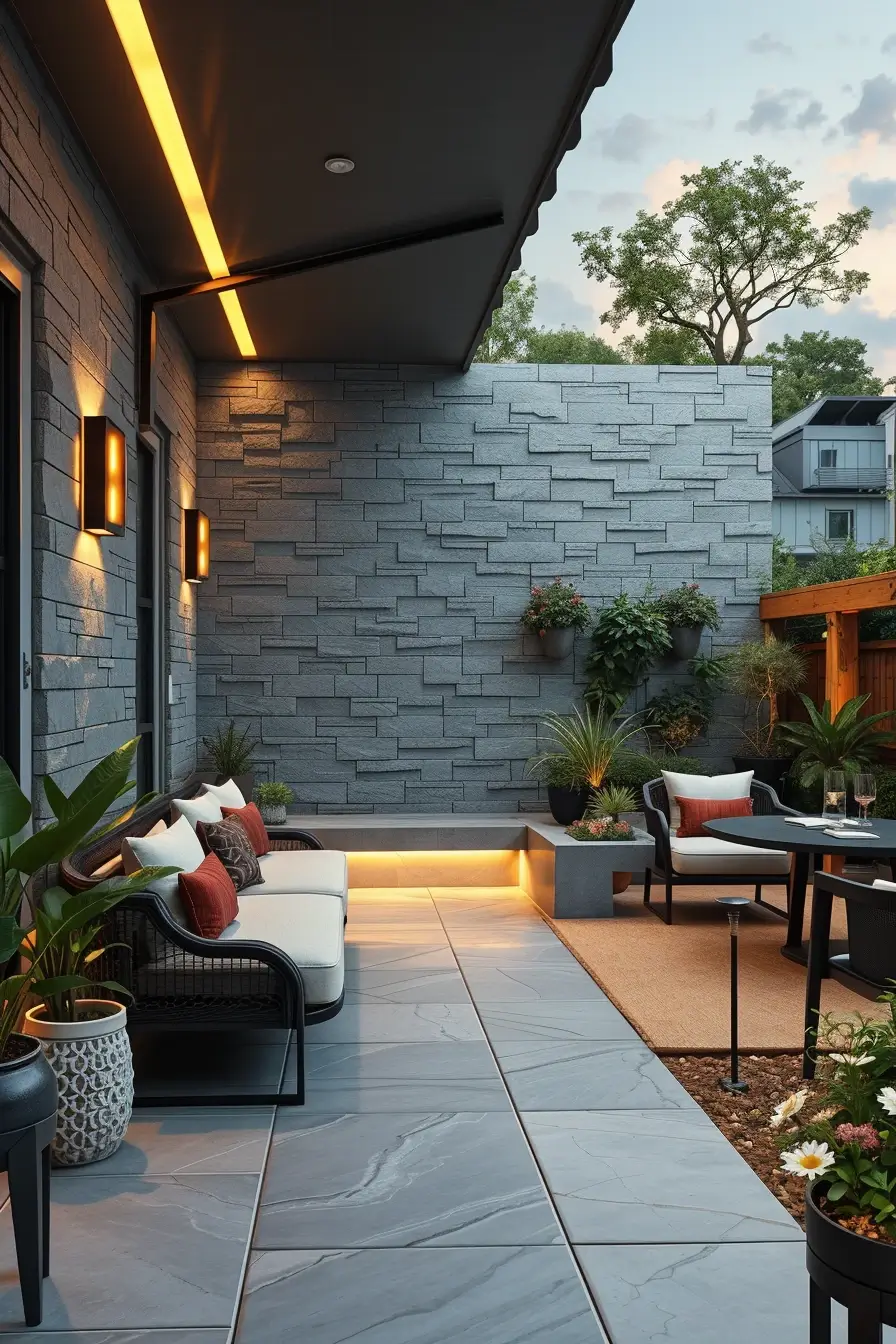
What transforms a stylish terrace from being simply beautiful into a livable and inspiring environment? How can we turn a mundane outdoor space into a sophisticated sanctuary for contemporary life? In this blog, I will discuss effortless methods and sophisticated innovations that can make elegant functional terrace artwork ideas. Every suggestion, from architectural elements to styling techniques, will be rooted in practicality and balance.
This guide also showcases expert layouts, contemporary styles, and the luxury finish touches that mark an urban balcony or rooftop retreat. Let’s elevate terrace design step by step with stylish design tips.
Features And Stylish Touches To Incorporate On A Modern Terrace
As for myself, I never fail to anchor my designs with minimalism, and in the case of terraces, its effectiveness is crystal clear. The simplest of all outdoor spaces can be a perfect example of serenity. Smooth, clean lines are essential, as well as neutral colors with soft textures and easy-on-the-eyes accents. Keeping the base color warm guarantees adaptability regardless of time of the year and climate too. Stylish terrace design ideas start with getting rid of heavy laced curtains to achieve flexibility coupled with open spaces that allow for easy meandering.

Achieving the desired aesthetic requires the integration of furniture such as modular seating that is low-profile, geometric planters, as well as concrete coffee tables. I prefer adding built-in benches to the seating and coloring them in subtle hues of grey, beige, and white. The outdoor patio cushions and rugs in solid colors paired with soft linen throws visually soften the space, but the concealed lighting retains a cozy atmosphere that does not overpower the design.
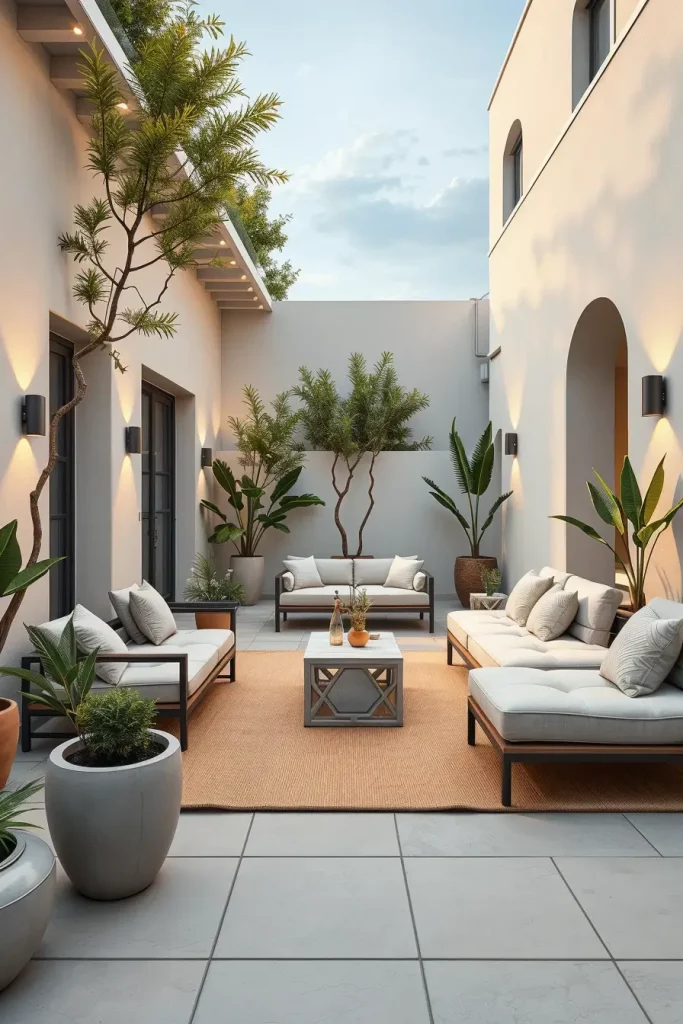
In my experience, clients enjoy the sprawling feel and tranquil atmosphere that comes with a minimalistic terrace design. As a design professional, I love using clear lines and uncluttered arrangements drawing from the recommendation of Architectural Digest to focus on fewer, higher-quality pieces. Geometric shapes create far more impact than people expect which reinforces my belief that, in design, less is more.
While discussing the architectural aesthetics of this section, I recommend choosing the finish of the walls carefully. Gentle stucco walls or cladding with a matte finish complements the rest of the minimal design and form without adding too much chaos.
Designer Furniture for Luxurious Outdoor Lounges
When crafting a luxurious outdoor lounge, focus on comfort that rivals the indoors. I never skip accentuated textures and handcrafted details. Stylish terrace ideas center around the use of weather-resistant, elegant fabrics and furniture that enhance the terrace’s visual appeal. For such pieces, consider using plush upholstery, teak frames, and curved silhouettes.
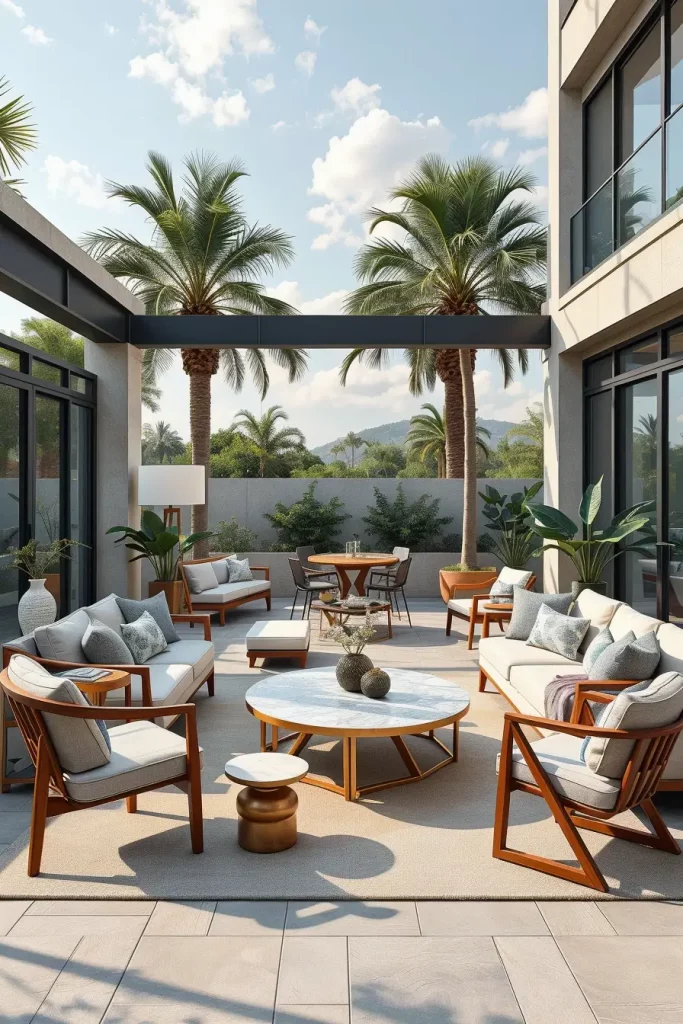
For myself, it is best to use sectional sofas combined with wrought iron armchairs topped with marble coffee tables. With sturdy style like B&B Italia and Dedon, my clients are guaranteed to get chairs with enhanced perdurable construction. The feeling of a living room, albeit in the exterior, can be achieved through oversized outdoor floor lamps, low-profile chaises, and sculptural side tables.

Personally, I have witnessed how dramatically people’s expectations change every time they transform their outdoor area with the right furniture. Just like what Elle Décor states, piece together statement outdoor furniture and instantly boost your living space’s character and property value.
For the last touch, what I would suggest is a texturized rug, weather resistant woven fiber on subtle patterns defining the lounge area while softening underfoot.
Sculptural Planters And Organic Green Accents.
When I think about terrace design, the addition of sculptural planters and organic greenery always comes to mind as they add life and movement. Enhancing air quality and softening architectural lines, these elements also create natural focal points. A terrace structure requires a balance between the layout and wildness of nature; culprits for bridging the difference beautifully are planters.
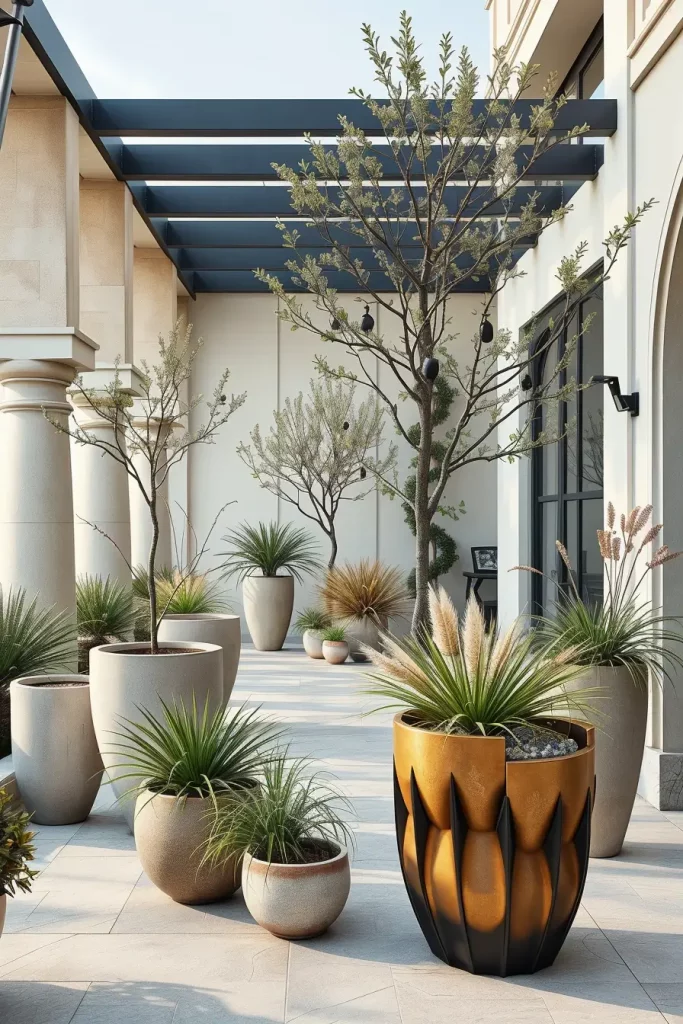
For example, I like using oversized stone, metal, or concrete planters in the shape of a curve, rib, or any other sculptural form. Filling them with olive trees, ornamental grasses, or cascading ferns adds texture and volume. I define and direct the eye by strategically placing seating adjacent to the planters as well as along railing planters.

Greenery enhances the vibe of a terrace, which, as a designer, I believe is of utmost importance. Even a few striking plants alters the ambiance from plain to polished. To add dynamic interest, Architectural Digest suggests incorporating height variations, therefore I mix tall, medium, and low foliage.
The only thing I would add is an integrated irrigation system, not just for aesthetics, but to effortlessly keep the plants vibrant. This small detail could enhance the terrace’s beautiful styling while making a difference over time.
Seamless Indoor-Outdoor Flow With Glass Partitions
Employing glass partitions in areas such as terraces makes the space feel grand, as well as have an unrestricted view of nature no matter where you may be in your house. They are particularly helpful with generously soaking urban terraces with natural light.
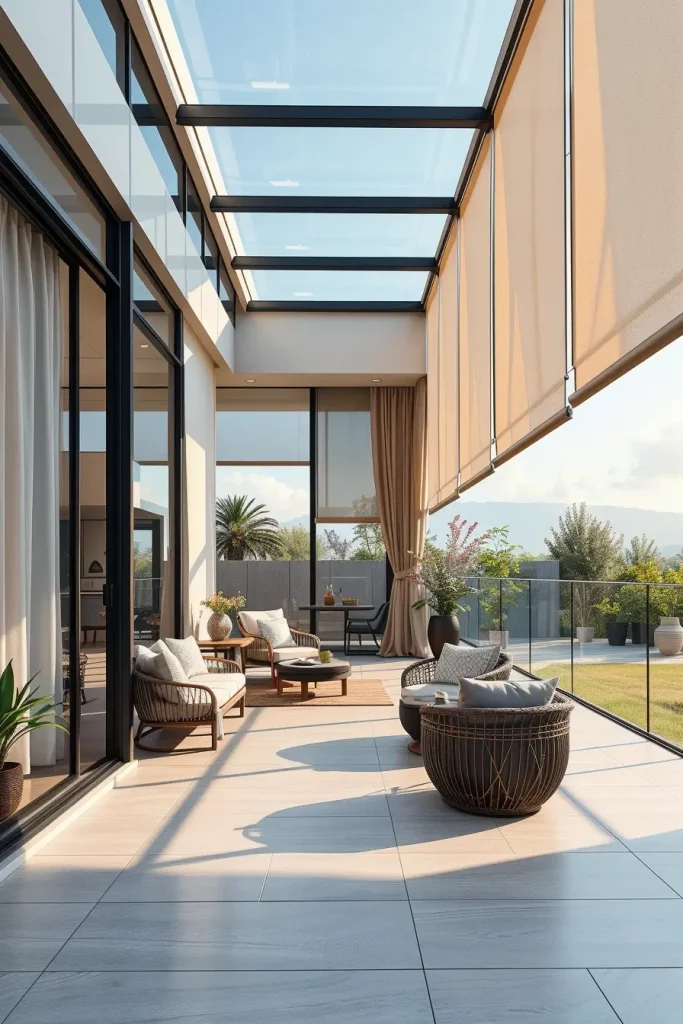
I use soft curtains or shades that draw back completely to provide unobstructed views of the outdoors while still having the option of privacy. This is combined with roller shades and floors that use the same tiles or floorboards in order to create that seamless blend between the indoors and Outdoors.
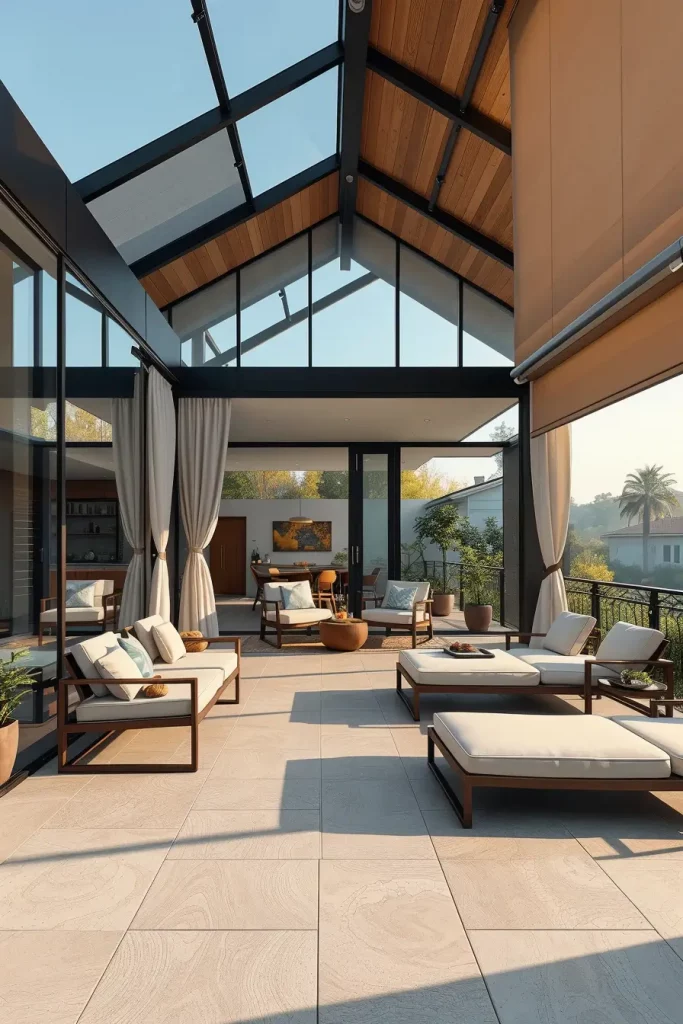
With Dwell magazine recommending the combining of zones using transparent dividers for flow, I have used their approach in my home and the end result was a refined living space that drastically improved the flow while enhancing practicality.
No matter what type of dividers or partitions are utilised, holistic design is accomplished through the ceiling lights that shine through the indoors. These lights reinforce the Indoors – Outdoors connection and serves as lighting the household at night, making the whole design feel wholesome.
Deck Terraces with Floating Step Designs
The combination of floating steps and an elevated deck transforms terrace design, both functionally and aesthetically. I apply this method to my designs to create multiple layers of experience within one outdoor space — lounging on one level and dining or gardening on another. Floating steps add a sculptural touch to the space with their clean lines and open risers, making the area feel bigger and more dynamic.
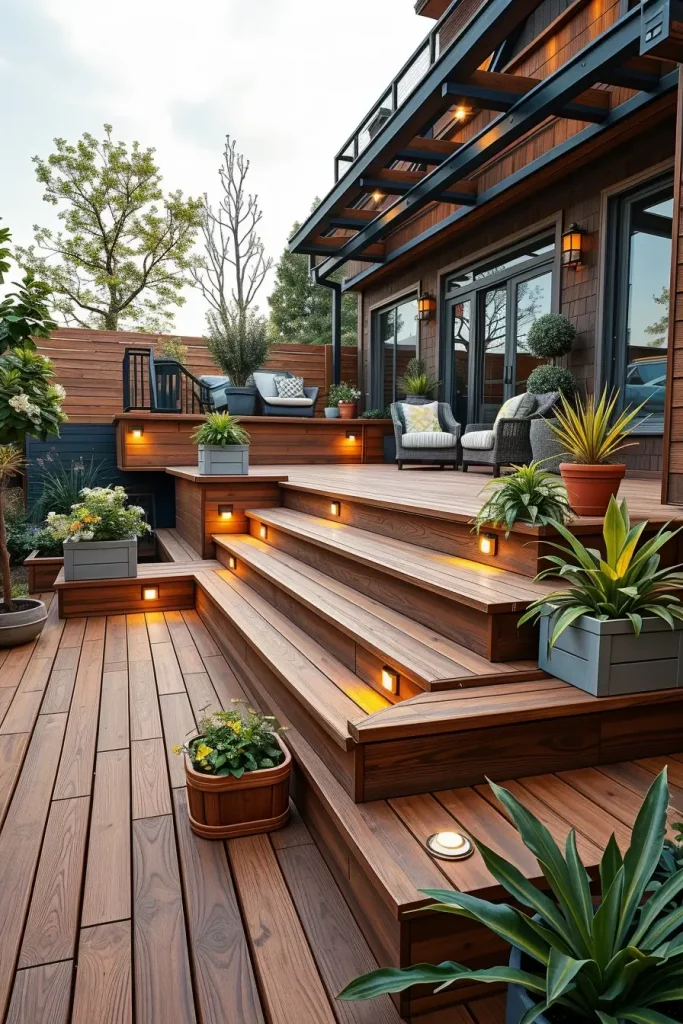
The choice of materials is important in this case. I prefer a deck made of ipe or thermo-treated ash hardwood, which is hidden beneath steel framing. The floating steps are usually cantilevered or minimally bracketed to allow for a more lifted appearance while still being seemingly weightless. LED set strip lights provide a warm glow after sunset when placed along the underside of the floating steps.

This design is not all for aesthetics. Clients often express appreciation for how these transitions make their terraces both more functional and unique. As House Beautiful points out, zoning through elevation divides multi-functional areas into smaller spaces within a compact area without them feeling overcrowded.
For this design, I recommend adding a low planter box near the steps as they help in visually softening where hard materials dominate while still being structurally supportive.
Statement Lighting For Nighttime Luxury
Every terrace design can be improved dramatically with the right placement of lighting. In my opinion, lighting is just as important as the other elements of the terrace, which is why I suggest to my clients to plan it much earlier into the design process. The right illumination makes a terrace into a luxurious evening retreat. The comfort, depth, and drama of the setting is transformed when lights are used to showcase textures, architecture, and furniture.
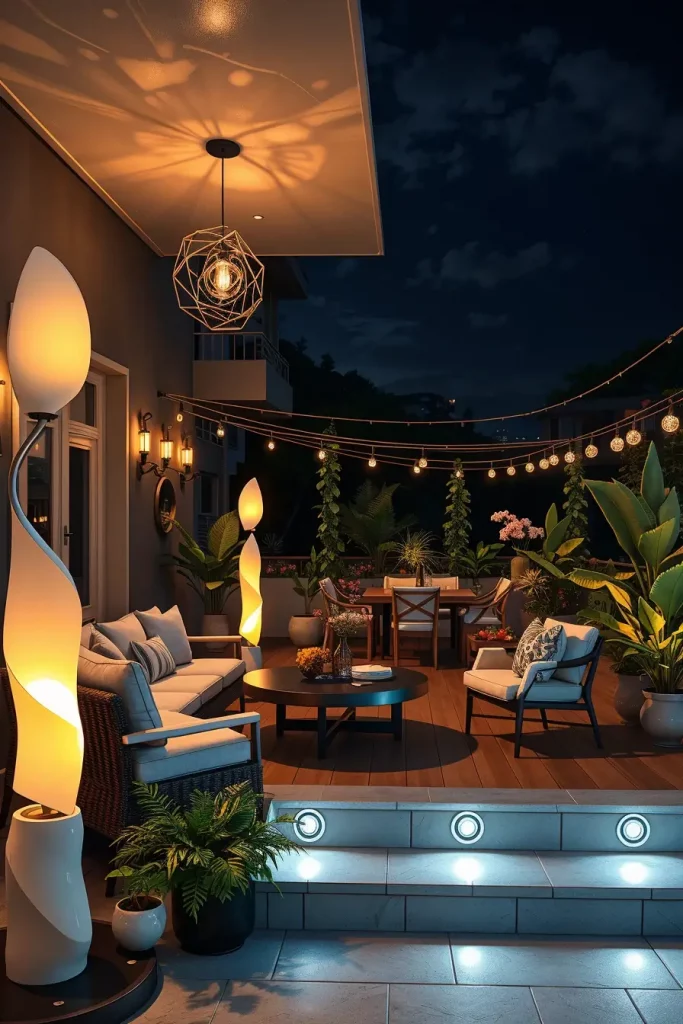
Dimmable warm-white lights that increase in temperature as they’re dimmed are preferable while mixing different light sources like pendant chandeliers placed above dining tables, wall sconces beside door openings, and low-profile LED uplights for vegetation. My best lighting pieces are sculptural floor lamps made from powder-coated aluminum.

The right lighting will significantly alter the terrace’s mood, and using warm lights it can serve multiple purposes at once. I was particularly struck by the luxurious sensation that layered exterior lighting can bring to a property, and it’s a realization that I discovered through a recent piece in Domino magazine.
Step lighting for deck edges and stairways can also be included, and are great for improving the overall setting as they serve an ornamental and handy purpose.
Textured Walls And 3D Panel Accents
Terrace walls also play a role in the design because, with the right texture, they can be very visually stimulating. I always support the addition of 3D wall panels, textured stone, or ribbed concrete for further differentiation, contrasting sight and touch. These details are particularly effective along longer walls or around enclosed courtyards.
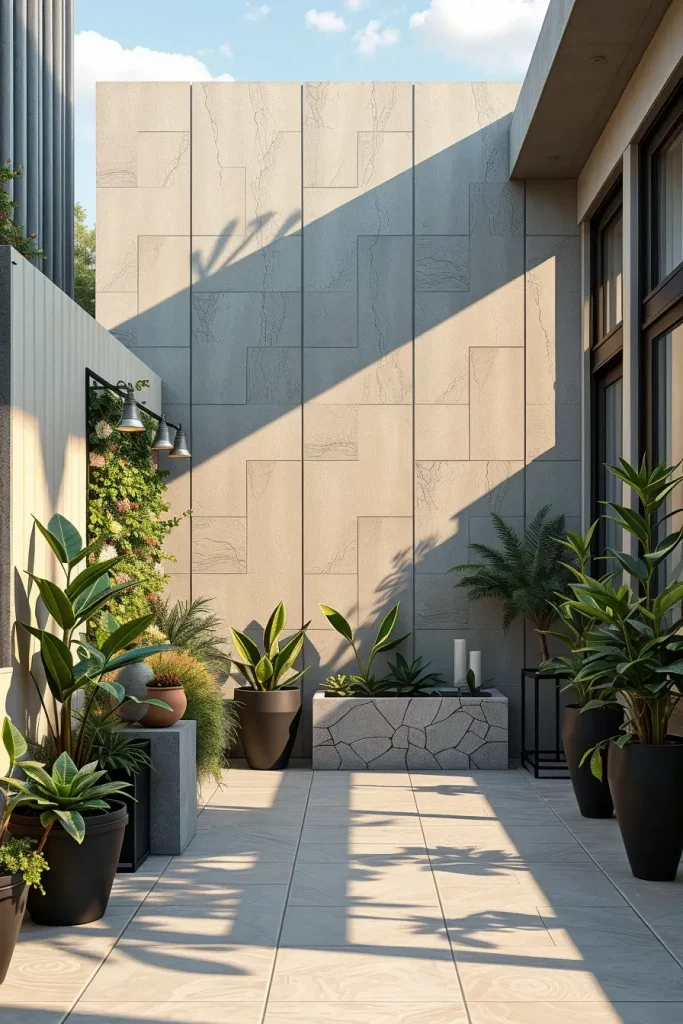
For barbecue terraces, I’ve defined the perimeters with slatted wood panels, some geometric concrete tiles, and sculpted plaster. These serve to deepen the dimension of the structure and capture light. Also, in order to meet my vision, I often go as far as extending the paneling to integrated planters or vertical gardens.
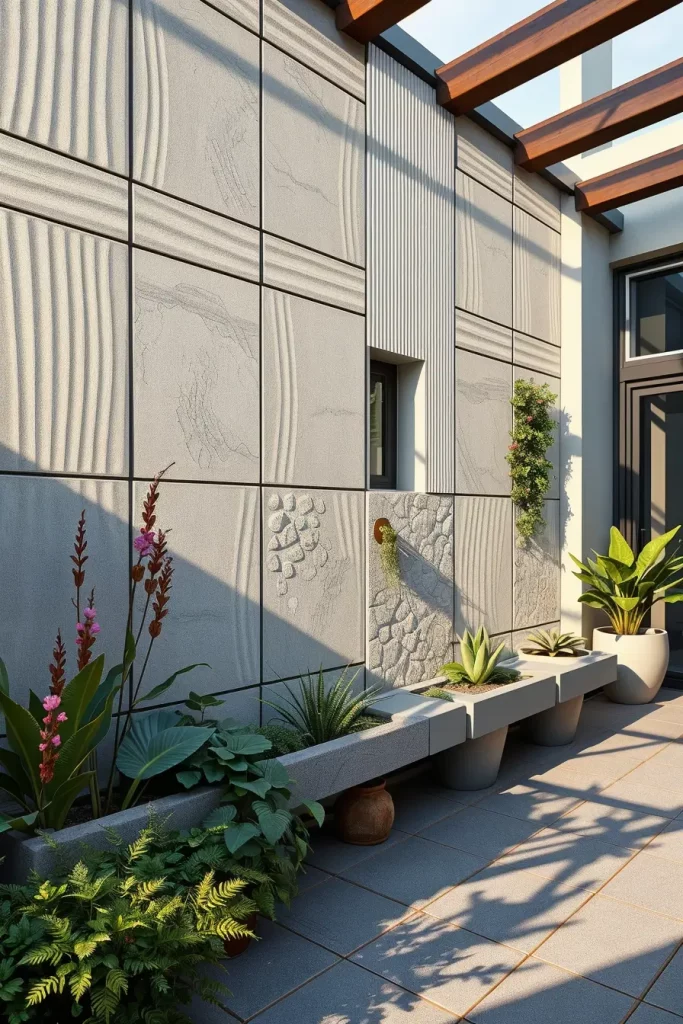
In my work, it is the textured walls that get the most compliments and, rightfully so, The Spruce features these outstanding walls as showcases that transform simple custom terrace furniture into an extraordinary statement piece.
What’s missing? Galina, as the wall is aesthetically so harmonious, I would add focus using curved ambient sconces and transform the walls into canvases for light and shadow extenuating the shadows and textures at night.
Sleek Metal Shade Structures With Architectural Style
Adding a well designed shaded area to your luxurious terrace goes beyond comfort and relaxation. It also enhances the visual architectural appeal of the entire space. The terrace’s shade structures, whether a fixed pavilion, slatted pergola, or cantilevered canopy, serve multiple sculptural functions. Their form and spaces created allow for zoning and sunlight control without the need to enclose the terrace fully.
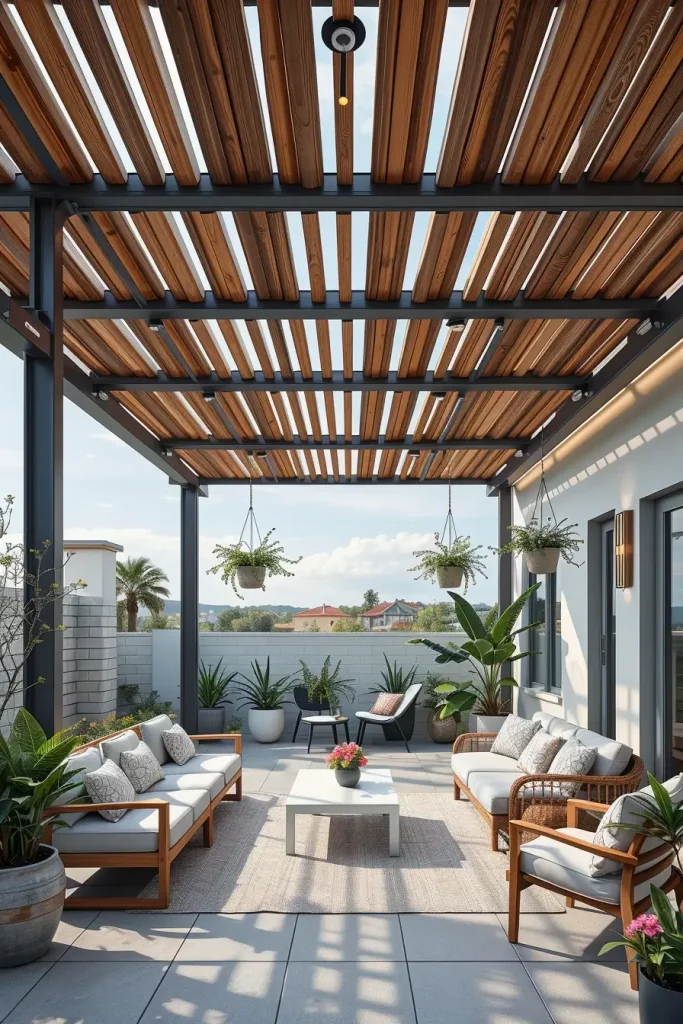
For this coastline style, I frequently incorporate metal or treated timber beams with strong spacing patterns. These joiners prove functional and help create amazing shadow effects on the flooring. They add beauty through enhanced lighweight planters and beams while adjustable louver systems add to the flexibility of the design.
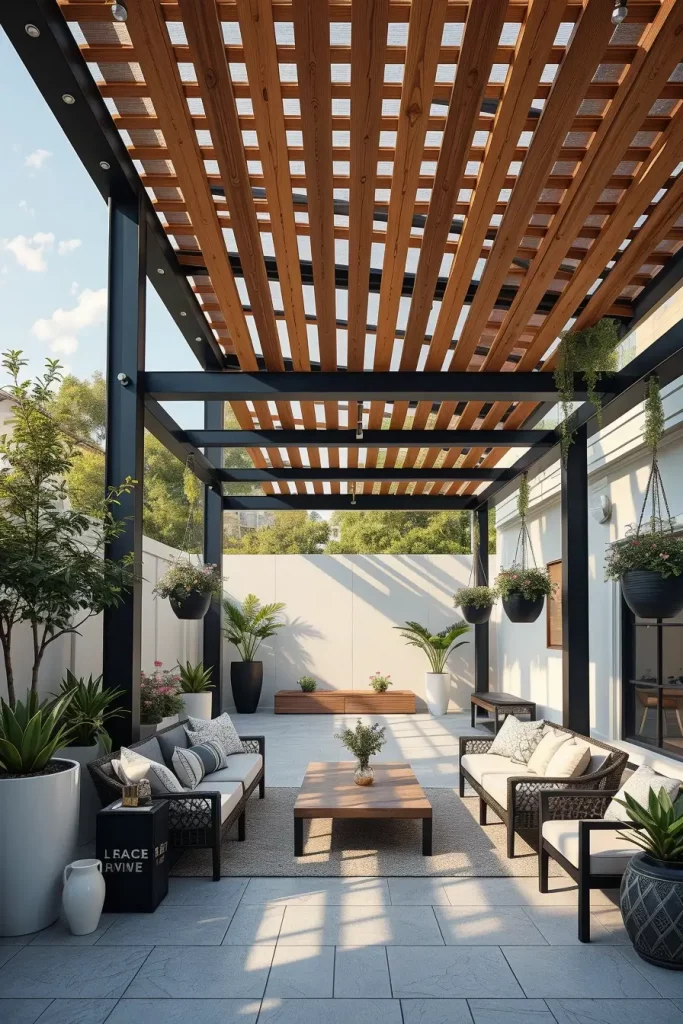
Modern pergolas have become visual anchors in terrace design. Extending the shade structures alongside custom planters always delight clients as they are practical yet elegant. They seamlessly blend reasoning in architecture having termed it smart design movement.
These ideal structures should include retractable fabric panels to allow for climate condition changes. It adds warmth making it ideal throughout the year.
Modern Hearth Elements and Designer Fire Pits
Having a fire pit or a hearth not only warm the area but also acts as a powerful focal point on stylish terraces. I place these pieces to set the mood for the warmer evenings or for the transitional seasons. Visually, people are escorted by the warmth and literally frosted by the heat, which encourages longer stays and cozy gatherings.
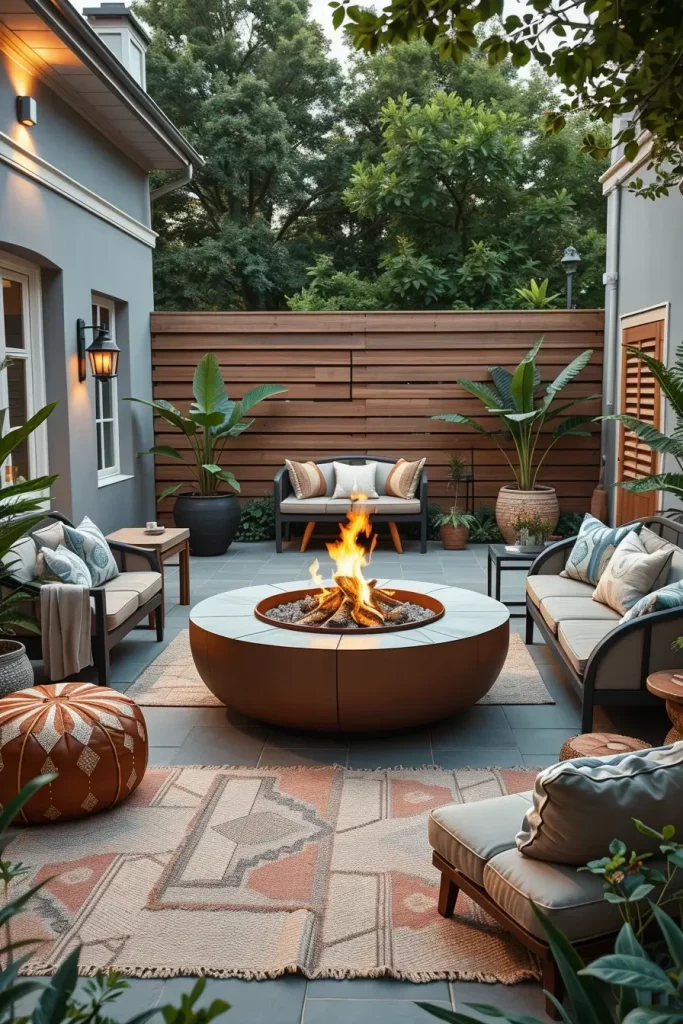
My go-to choice includes sleek fire bowls made using blackened steel, concrete, or corten steel along with built in seats. Linear gas fireplaces are preferable for more architectural terraces as they often come with glass windscreens and remote-control functions. I also include niches for firewood storage that help in decoratively doubling as design elements.

People are usually surprised by how much they appreciate a well designed fire feature. I do agree with the editors of Dwell magazine on this one. Moder fire hearths turn out to be low maintenace and definetely sculpturally refined as opposed to rusty.
To make the scene even cozier, it would be great to include lounge poufs and a woven blanket basket. As for the hearth its surrounding gravel or stone mosaic would make perfect centerpiece.
High-Contrast Color Palettes With A Contemporary Edge
Having a high-contrast color scheme will add that finishing touch to terrace designs thereby providing a polished look, a high-end personality and can improve that design in an instance. I use black and white together, charcoal with tan, deep green with brass, and many more when trying to accomplish stark and sleek contemporaneity. There is always drama while remaining tasteful with the sophisticated counterparts.
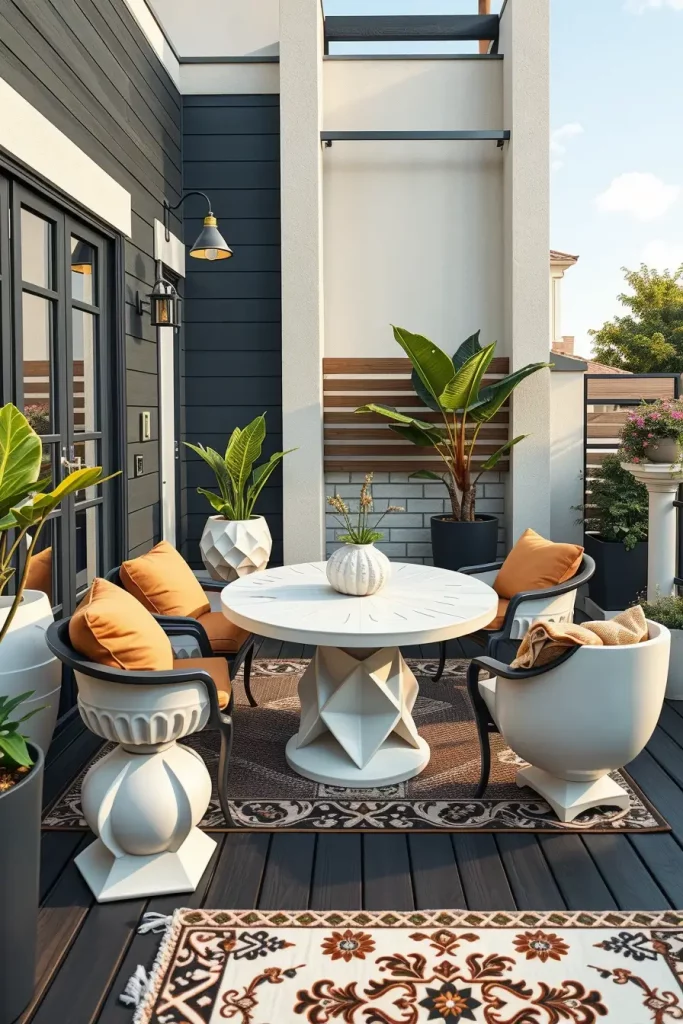
Dealing with furnishings and color design is very important in this scheme. Side tables that are Ceramic and black chairs framed with matte black also yield cushions in reddish brown or rust which brings high juxtaposition. Alongside using dark wood decking I try to use light color dressings which helps strike the balance towards achieving harmony. Items like rather bold patterned rugs during accent pieces or sculptural planters help transform the entire plan.
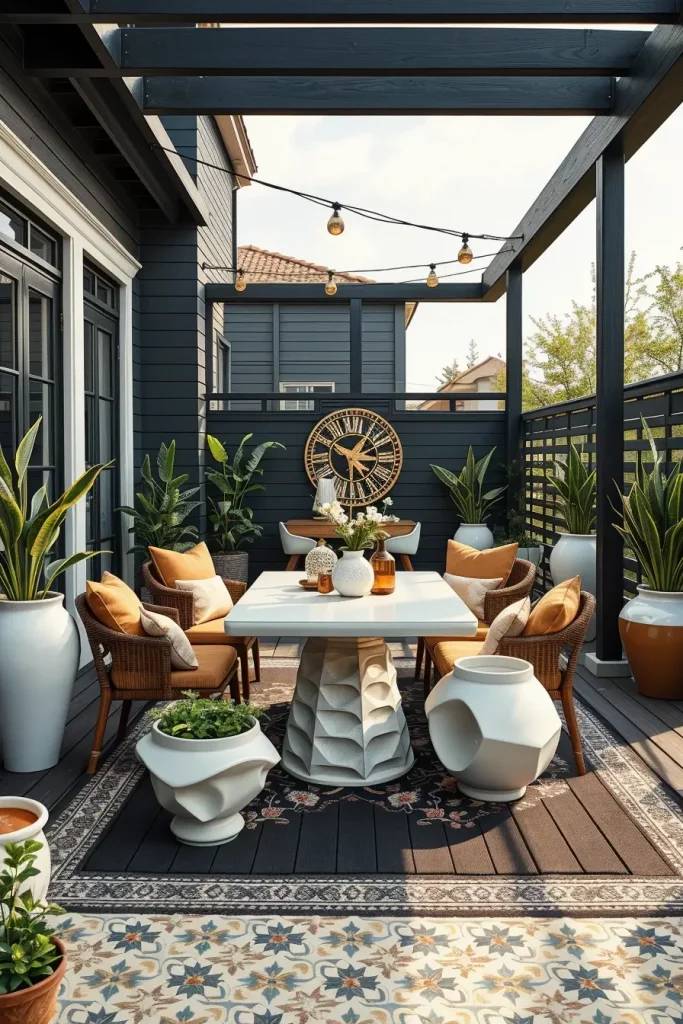
The balance achieved is rather relatable to clients for it gives them the look and personality that is crisp and sharp. Utilizing opposing colors in modern builds is rather critical and also helps add clarity to spaces along the visual movements in that design – House & Gardens. Precision leads to balance and is best for achieving none overwhelm feeling.
Black lighting fixtures can go a long way but adding them on bold walls along monochrome terress makes add a strong centralized color story unground.
Built-In Benches With Geometric Lines
Seating terraces using built benches enhances the value of the space and integrates it into the design of the house, oh and did I mention my favorite part of this feature. Either enhancing or creating terraces which can be described as visually seamless, has always been one of my favorite design touches.
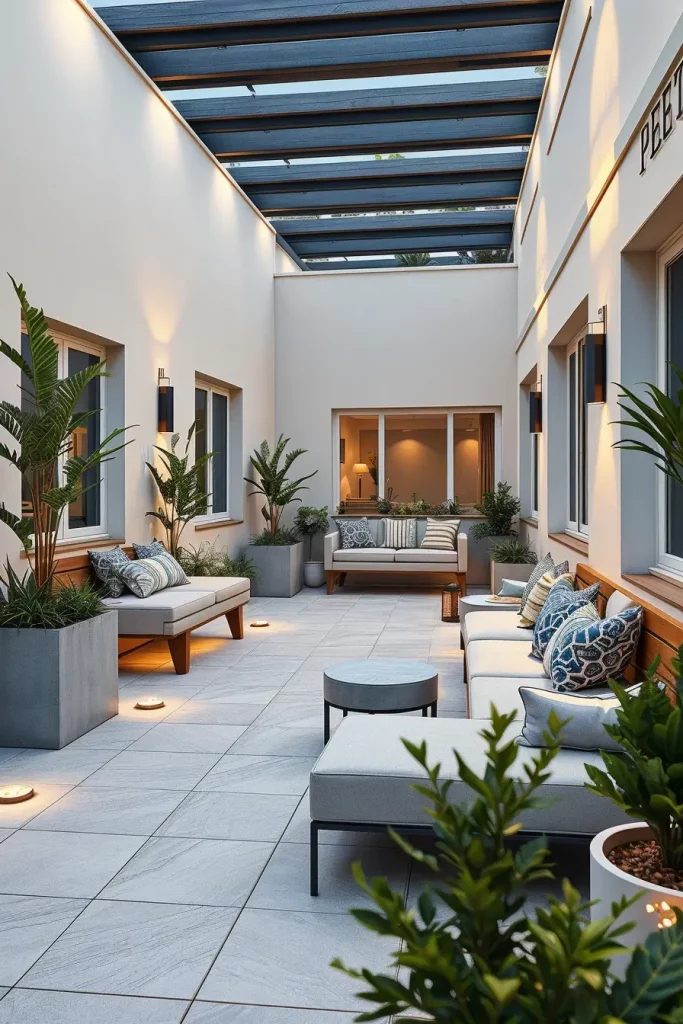
Loos that I use for design are fashion stucco, smooth in concrete, poured, dirty wood, and capture soft rectangular shapes. To further enhance these steps, soft custom bolsters in plain or vibrant fabrics can be added depending on the overall theme. Inviting conversation while grouping seating arrangements is achieved by using backless benches which are flattering and L shaped configured corners.
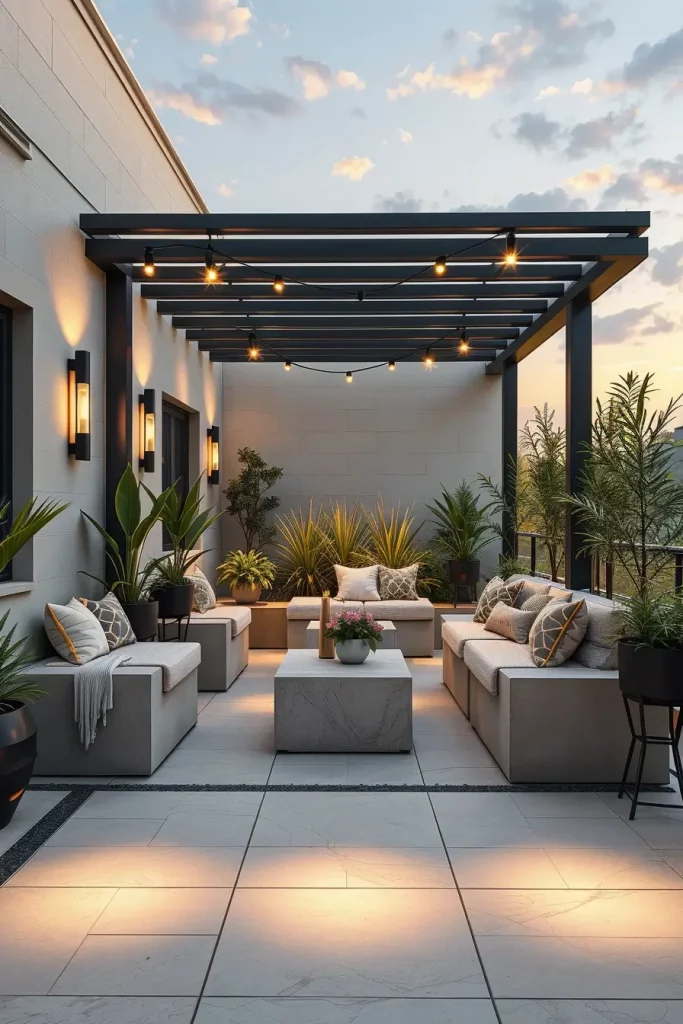
The response that I get from clients is always positive because of the aesthetic and practical advantages these pieces possess. In the words of Interior Design Magazine which I strongly agree with, geometric built-ins are steadily rising in demand because of their architectural beauty and clever integration of seating where it would be considered clutter.
This is most relevant to smaller terraces so that are space sensitive. If given the option, my ideal suggestion would be having the ability to incorporate lighting under the front edge of the bench. By doing this, supporting illumination makes it easy to see the underside of the bench base at night.
Exceptional Materials: Concrete, Marble, And Exotic Timber
Using materials such as marble, concrete, and exotic timber not only conveys sophistication and luxury but also garners attention. These materials are my choice for designing terraces because they stylishly blend with nature while also working as great performing surfaces for outdoor areas. Material choice is critical in terrace design, and I aim to achieve the same care and finesse as curating an interior. These traits alone make a design stand out.
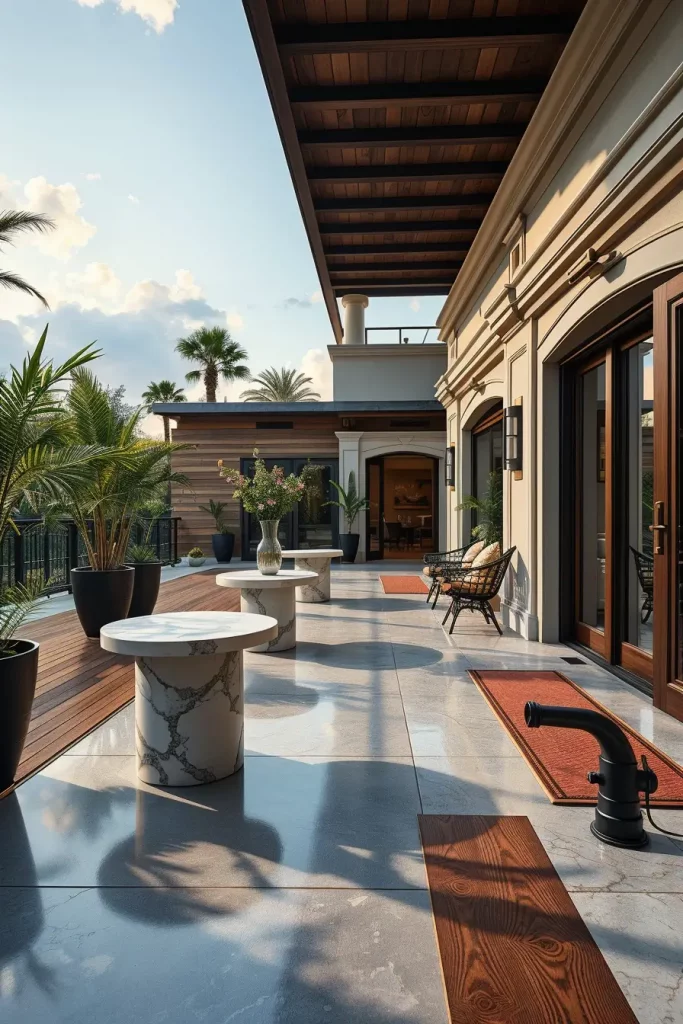
Marble honed to perfection makes for elegant side tables, water features. They pair well with smooth concrete planters and flooring. Teaks and ipe wood make the best decking furniture too. Considering polished brass or matte black alongside these materials only enhances the warm stone and industrial concrete.
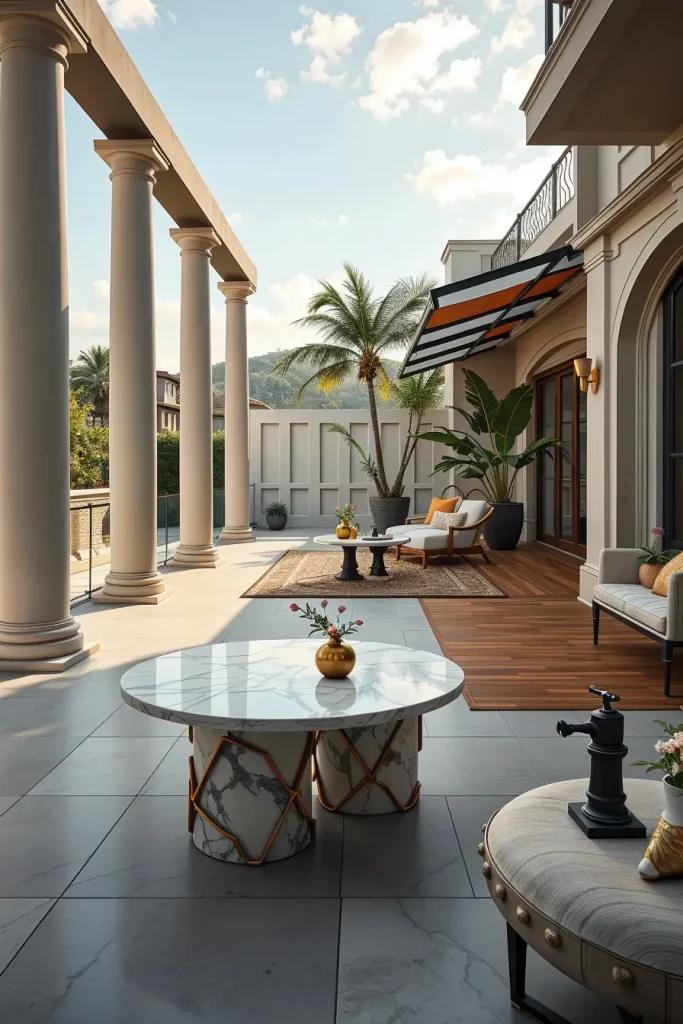
For outdoor spaces, I find finesse within my work. Having spackled textures with specified colors provides a unique outlook while keeping together with the rest. Designing this way makes me appreciate Elle Decor for going all out and putting their name on it.
With further customizations, like timeless elegance, the polished brass stands out from the matte black. For concrete planters and flooring, the stones look great.
Zen-Style Terraces With Gentle Water Features
The design of Zen terraces captures the calm simplicity that many searching for elegance would appreciate. Following Japanese and minimalist traditions, this design balances neutral color palettes with soft shapes and the use of elemental materials. A quiet water feature like a reflecting pool or stone basin serves as the heart of the space.
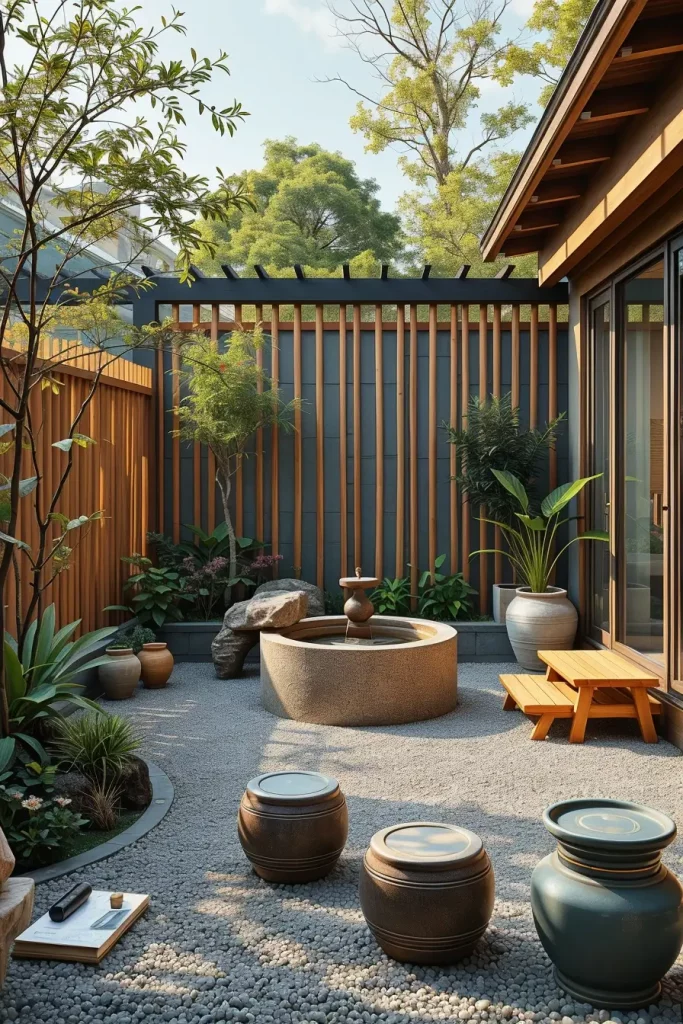
My preferred flooring is gravel or polished stone with bamboo fencing or wooden slats. My choice for furnishings includes low teak platforms, ceramic stools, and linen cushions, which result in a modest look. More often than not, the water feature is tucked away in a corner overflowing with greenery, which helps foster self contemplation and promote relaxation.

As the Wellness section of New York Times Styles said, outdoor wellness design is highly sought after and popular in modern culture. With the direct stress-relieving results I have personally witnessed, this approach can be effective – even for a modest terrace. These locations are somehow astonishing, timeless, and soothing all at once.
Consider further enhancing these terraces by adding soft lanterns for evening use, and lavender or rosemary for scent layering.
Ultra-Modern Pergolas With Integrated Technology In The Roof
Permaglons have truly undergone a technological visage shift and its modern versions incorporate everything a contemporary home requires. The homeowners who love a stylish cape that can be adjusted based on their mood and weather will adore this option. Weather detecting sensors, built in lighting, and remote-controlled louvers are just some of the amenities that these smart red pergolas offer.
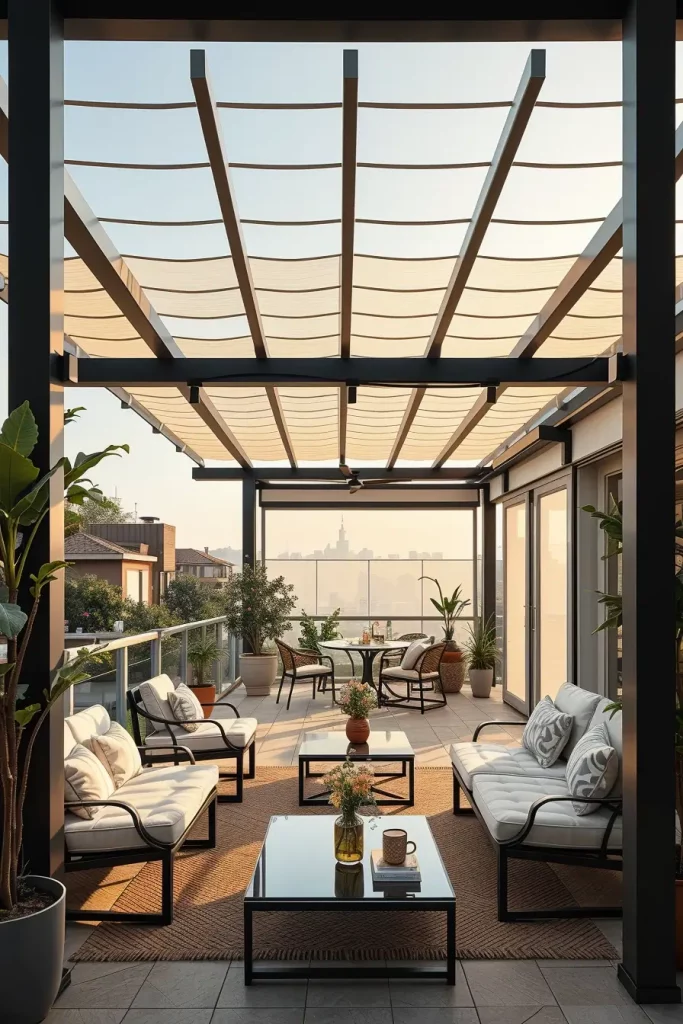
I mostly work on structures made from powder-coated aluminum which have drainage incorporated in them. Sunlight can be let in through the channel strut windows and rotatable roof blades, and for added entertainment, LED strips can be controlled via Bluetooth from the columns, or other, inside the pergola.
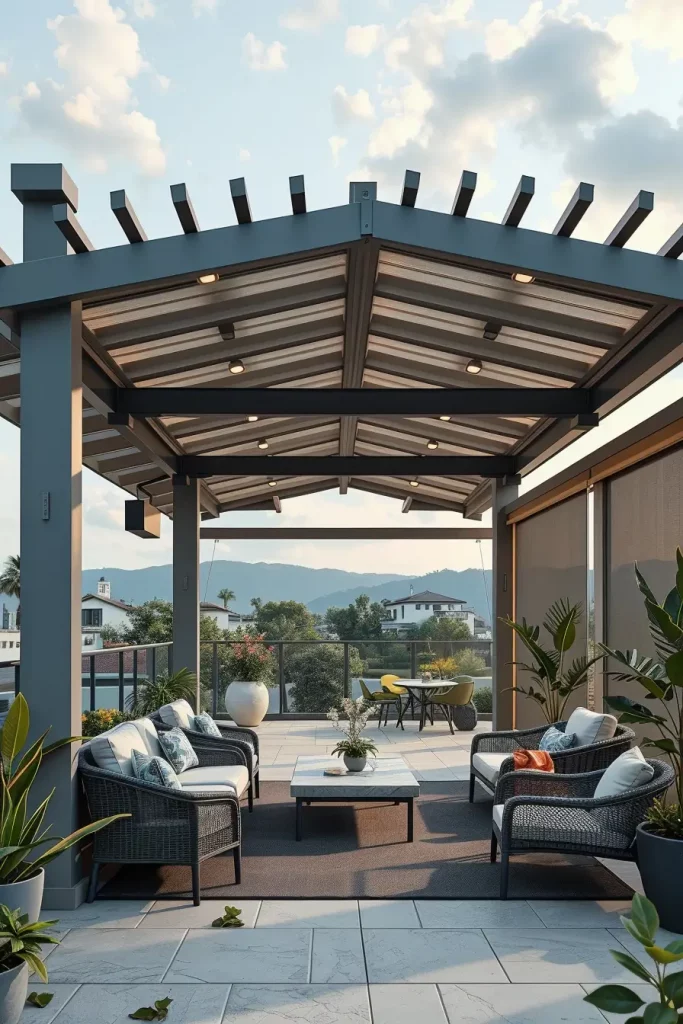
Clients love having a smart home, and the new sense of control this technology provides them. Smart pergolas are in almost every Modern Home magazine. The intelligent construction adds both value and utility to modern homes since they can be set up for use anytime during the year, no matter how harsh the conditions outside.
Their use feels endless. For enhanced privacy or wind protection, I’d also integrate retractable screens, but only if the budget allows. Relaxing in the evening or enjoying shade during the daytime becomes significantly easier if one is able to seamlessly adjust these.
Selected for You: Art and Sculptures For The Terrace
My recommendation has always been for clients to regard their terrace like any other room in the house, which includes the walls and corners. Adding curated art and sculptures elevates the terrace into a personal gallery, bringing texture, narrative, and an additional polish. This is particularly useful for homeowners who want to creatively design, yet optimized and purposely streamlined.
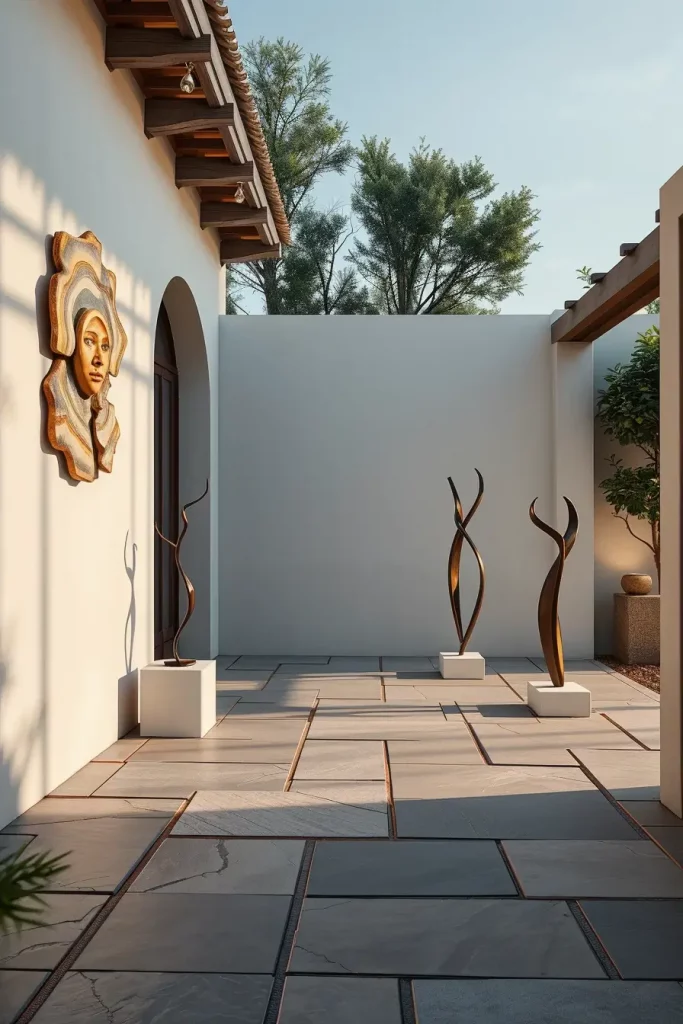
In the case of sculptures, I typically have them weatherproofed and select those fashioned from stone, metal, or treated wood. I place them in focus points of the terrace such as corners, wall niches, or amongst the greenery. Busts or abstraction displays can be set on the low plinths which I also recommend, allowing the design to rest on them visually while diversifying the heights. Artworks in the form of ceramics or resin also add character while being wall-mounted, meaning they do not occupy any floor space.
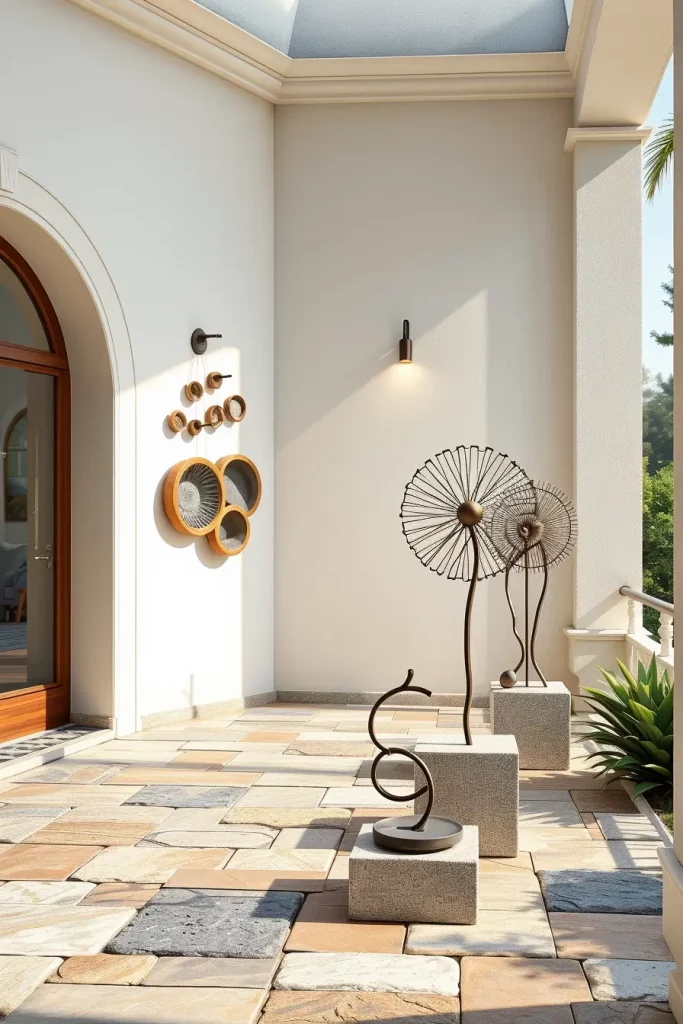
For the personal touch, combining cultures motifs and abstraction sculptures seems to be out of place but, from my experience, works well in propelling the entire terrace decor. Designers such as Martyn Lawrence Bullard reason that “outdoor décor should be as intentional as indoor” and that is the primary design strategy.
To hone this design further, I would consider integrating a few spotlight fixtures aimed at select pieces to accentuate them at night. This improves atmosphere and puts focus on the art while not drawing attention from the rest of the layout.
Privacy Screens That Double As Design Elements
When considering the design of urban level terraces, privacy is perhaps the top concern. Instead of using unaesthetic blockades, I suggest that clients spend their money on privacy screens that serve as design pieces. These multifunctional elements elegantly partition spaces for privacy and create visual intrigue while allowing air and light.
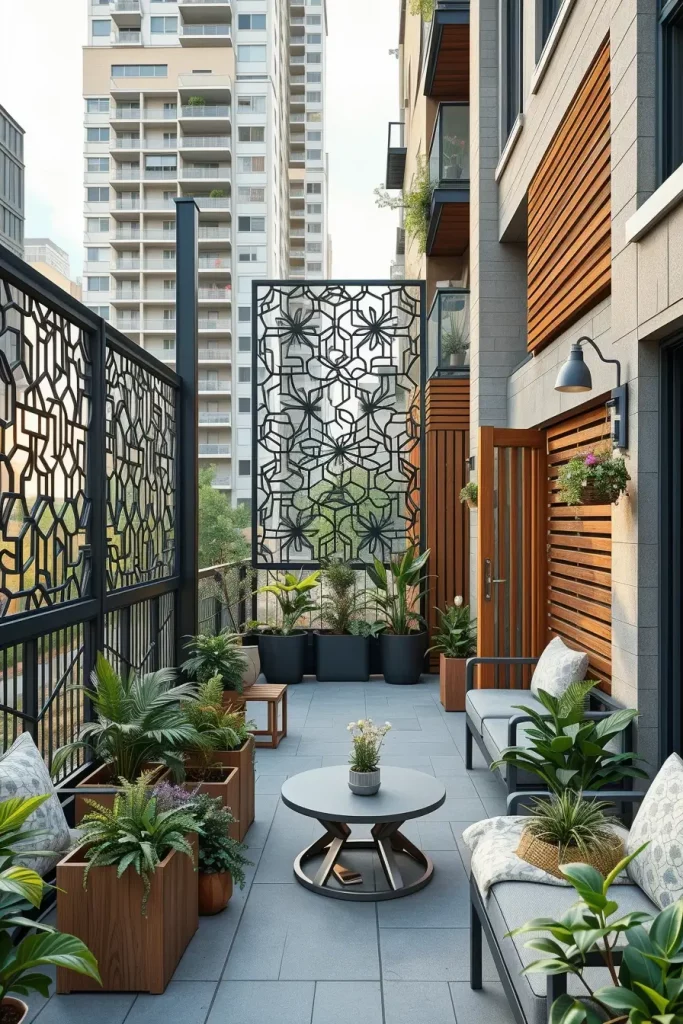
My go-to suggestions include laser-cut metal panels, wooden louvered slats, and vertical gardens on trellis mounts. Each brings in wonderful texture and character. Bold geometric shape screens or those that feature hollowed plants are strikingly beautiful and provide some level of touch.
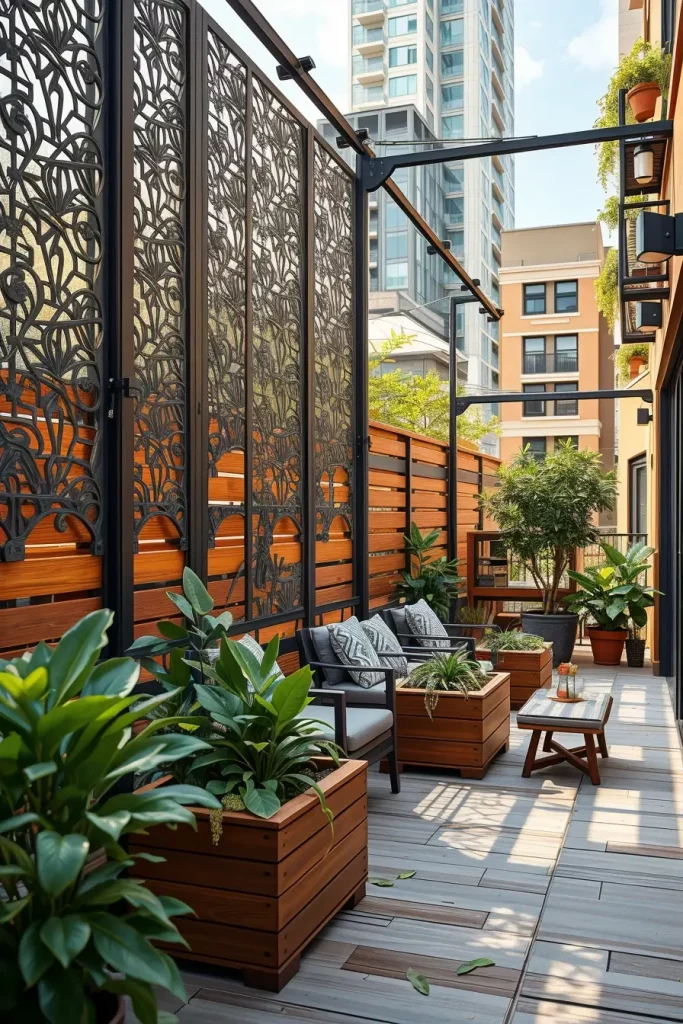
For one of my clients in Miami, I used a powder-coated aluminum screen with Moroccan patterns. It not only protected the clients’ terrace from overlooking neighbors, but it also created stunning shadow patterns throughout the day. This magazine Architecture Digest and publications have been mentioning this as an emerging trend in outdoor living.
To build upon this idea, I would propose placing integrated planters at the base of the screens. This addition enhances the design by softening the edges and adding greenery.
Contemporary Outdoor Kitchens With Sleek Lines
An outdoor kitchen on a terrace does not have to be bulky or take up too much space. It is ideal that the lines are clean and the materials are cohesive. A modern terrace includes a streamlined kitchen setup with stainless steel cabinets, stone countertops, and barbecue grills incorporated into the design.
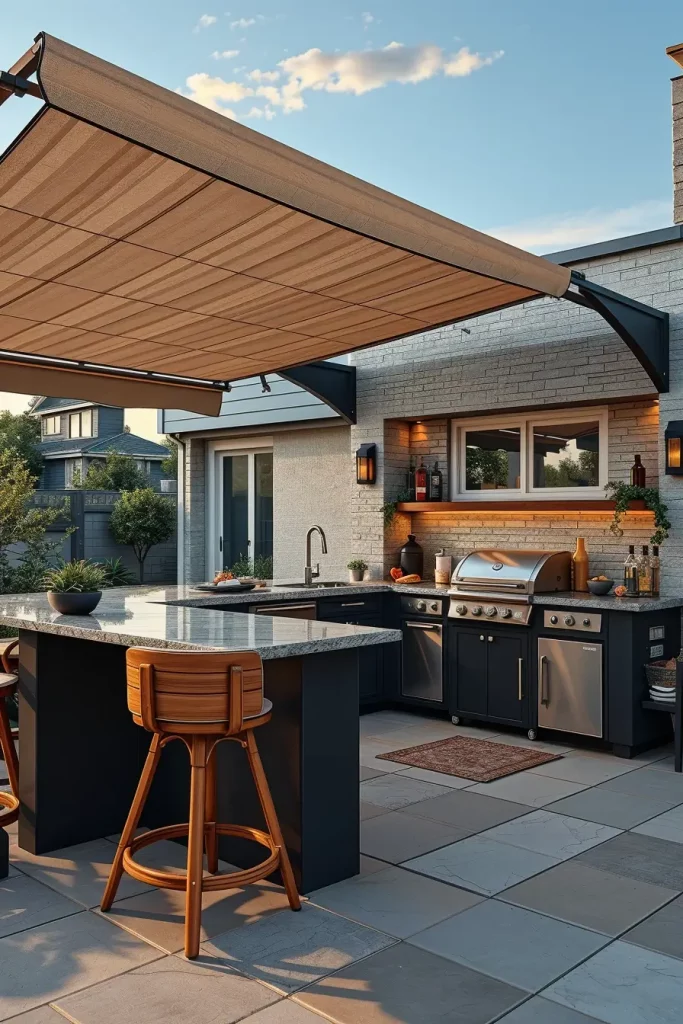
That is the essence of functionality without clutter. Add storage solutions, matching barstools, and a secondary backsplash or cladding that blends with the rest of the kitchen. For me, elegance means sliding cabinet doors and integrated sinks without having to deal with exposed edges.
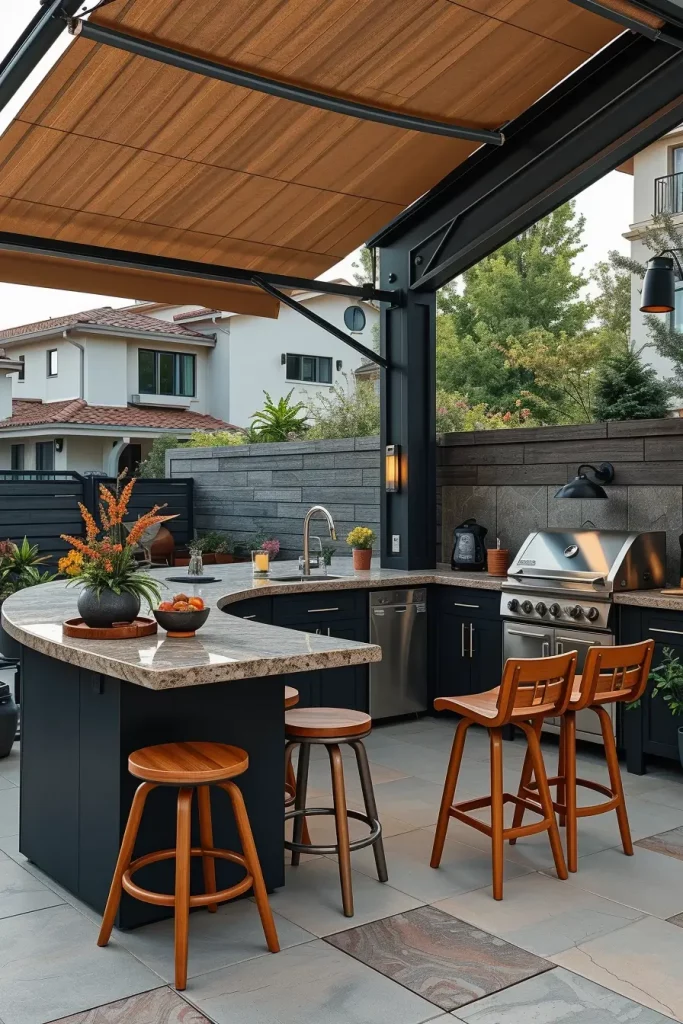
I, personally, have completed a project where a romantic luxury terrace was showcased with a matte black kitchen island and teak wood accents. Dwell Magazine informs us that monochrome, sleek kitchens are the future for outdoor urban-esque designs.
In order to further build upon this design, I would add under-counter LED lights and a weatherproof retractable awning to create a top-tier terrace experience.
Statement Planters with Sculptured Topiary
Apart from softening hard landscape edges, statement planters filled with sculpted topiary always seem to do one thing for me – frame the terrace layout. Sculpted topiary provides both greenery and architectural outline helping in the room like strcuture of any stylish terrace.

In my experience, oversized fiberglass or concrete, neutral toned planters do the job. They are chic and durable. For the greenery, “ethereal” is how boxwood spheres, spirals, pruned olive trees meander—easy to maintain, looks gorgeous all year round.
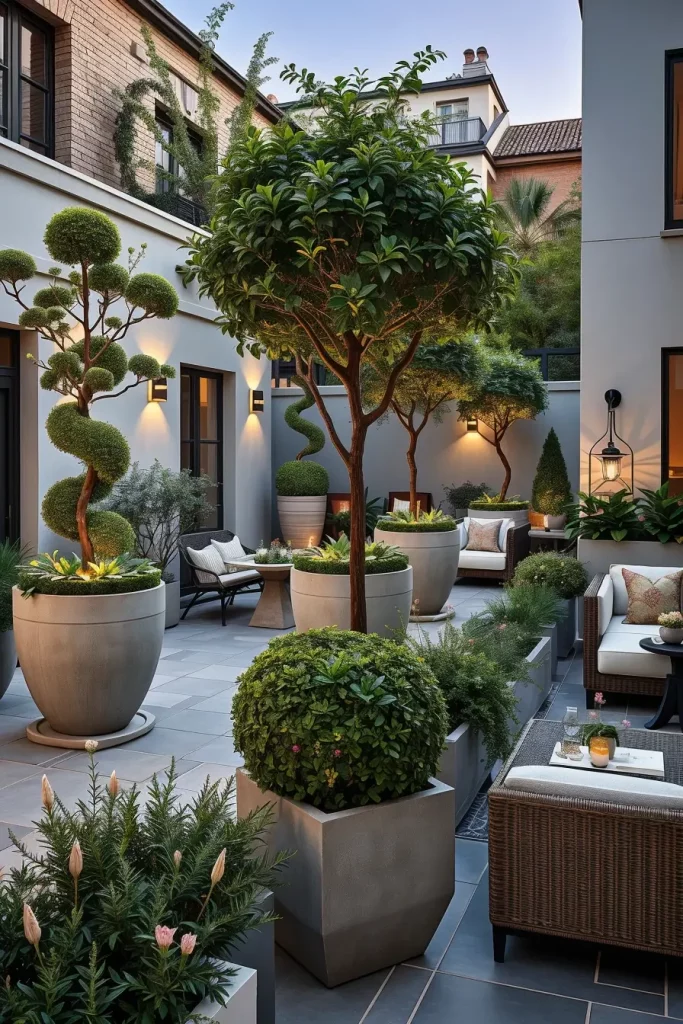
“An epitome client of mine flanked a lounging area with two rows of symmetrical box planters. This resulted in a grounded yet formal tone.” Topiary, as pointed by Elle Decor, can be immensely regal or adorably cheeky, depending on the styling and layout of the terrace.
“For more visual interest, I would add uplighting at base of the planters or play with scale and height for rhythm and layered effect across the terrace.” That would provide stronger visual impact.
Designer Outdoor Rugs for Textural Layering
Design rich terraces tend to finish flat without layering. Under foot comfort is why designer outdoor rugs are always part of my inclusion list and are used as stratigical means to establish zones and provide texture. Instantly, a rug transforms and ‘anchors’ a seating area, elevating the entire space.
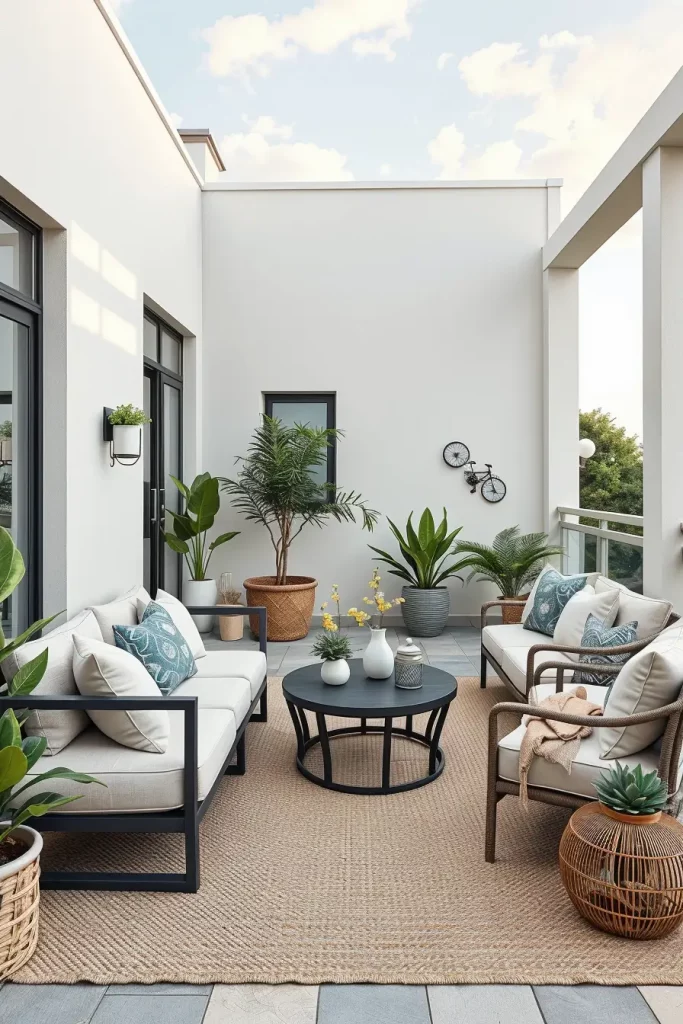
I generally prefer UV treated rugs crafted from polypropylene or PET yarn. They come in prints from understated textures to bold geometrical patterns based on the design of the terrace. So, a rug with neutral colors and a woven texture will work beautifully for most places.
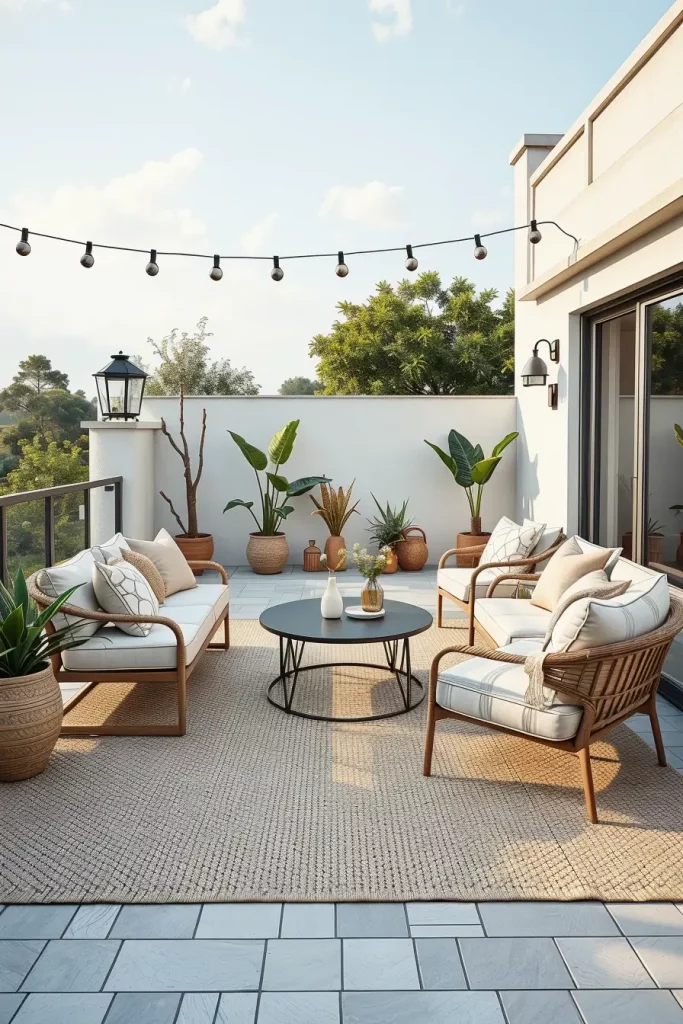
In my experience, even the most minimalistic terraces benefit from having a tactile base. I recall being a part of a project where a black and white herringbone rug delineated an entire seating area which complemented the neutral toned furniture perfectly.
To complete the look, I recommend coordinating patterns or colors for throw pillows or poufs. This helps zone the terrace more efficiently and brings cohesiveness to the entire decor.
Layered Lighting: Recessed, Lantern, And Strip Options
I do not think there is a terrace that feels complete without well-placed lighting. I personally, am an advocate for layering lights since it adds flexibility and space. Recessed lights in the ceiling, elegant lanterns on the table, and LED strip lights under the edge of the furniture makes the space effortless transition from day to night.
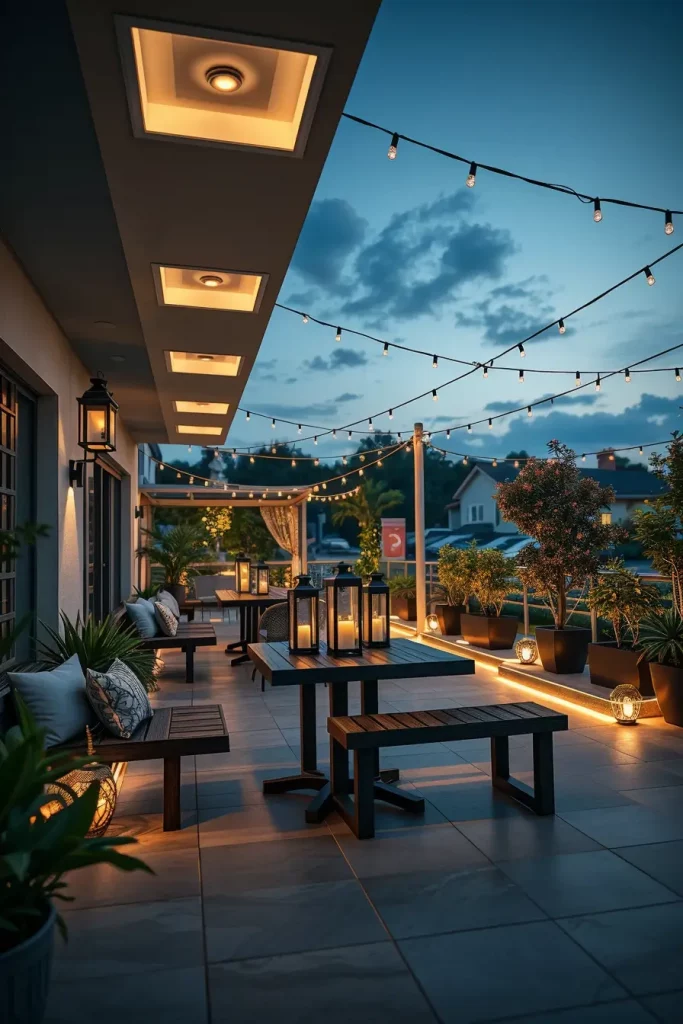
Each type of lighting plays a role. Primary illumination is provided by recessed lights, while ambient and stylish lanterns add decoration. Emphasizing the outlines of furniture and floor is done through strip lights. I recommend using warm temperature colors for the lights to achieve contemporary cozing atmosphere.
A project I completed in Los Angeles showcased teak ceiling panels that had lights recessed into them, as well as minimalistic bench lighting underneath a floating bench. It was magazine-worthy because of the warmth and drama it exuded. As noted in House Beautiful, the best terrace lighting is multi-dimensional and can be adjusted as needed.
In addition to the suggested lighting, I would add accent lights that are solar-powered around the planters for easier flexibility, or smart app-controlled lights for ultimate control.
Architectural Terraces With Tiered Levels
Incorporating movement, perspective, and architectural interest to terraces of all types is effortless with tiered design. This is optimal for large spaces, or terraces located on split-level homes. Each level can serve for a distinctive purpose such as lounging, dining, or even a small garden retreat.
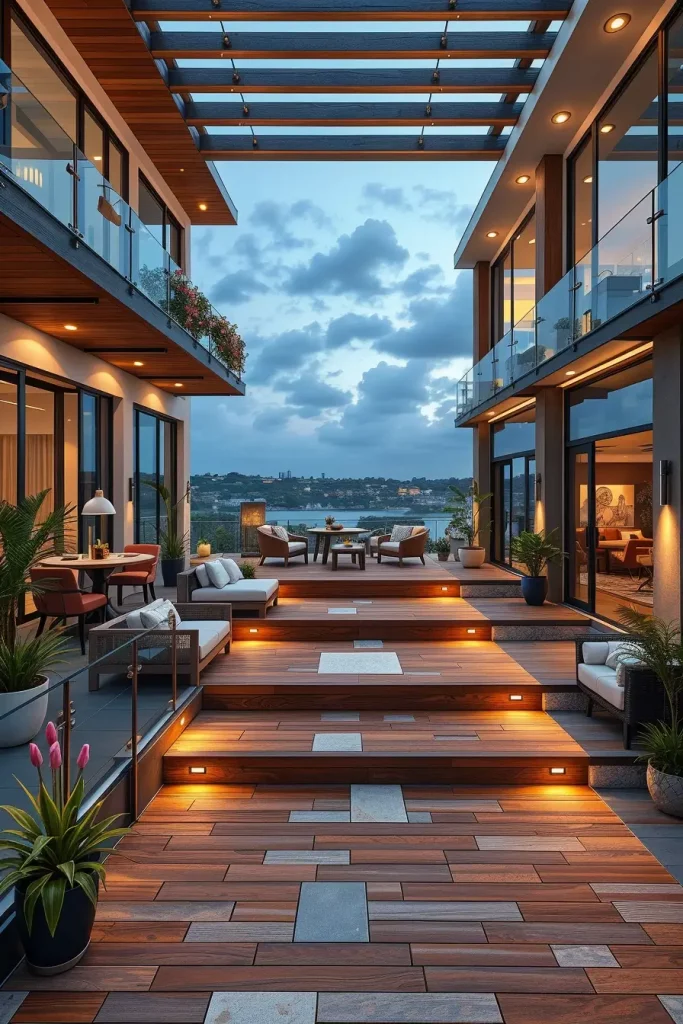
Using materials is a great way to define levels; I like doing it with wood decking for one zone, stone tiling for another, and steps that have lighting integrated into them. These designs facilitate an easier flow for the terrace.
One of my most successful projects included three staggered platforms that had floating steps, which created a cinematic terrace experience. As stated by Veranda Magazine, outdoor multi-level spaces can easily be made to resemble luxurious resorts if executed with detail in mind.
To improve safety without taking away from the view, I would implement structural glass dividers on the higher tiers and railings. This would enhance the polish and usability of the space while maintaining sustainable details.
Terraces Developed with Gardens and Landscape Borders
The approach of having minimalist terraces framed by linear gardens greatly appeals to order lovers, which is why it is commonly chosen. Such spaces focus on cleanness, order, and balance. It tends to revolve around geometric structures, use of moderate materials, and merging of the inside with the outside. This is great for people seeking a sophisticated retreat that is easy to maintain.
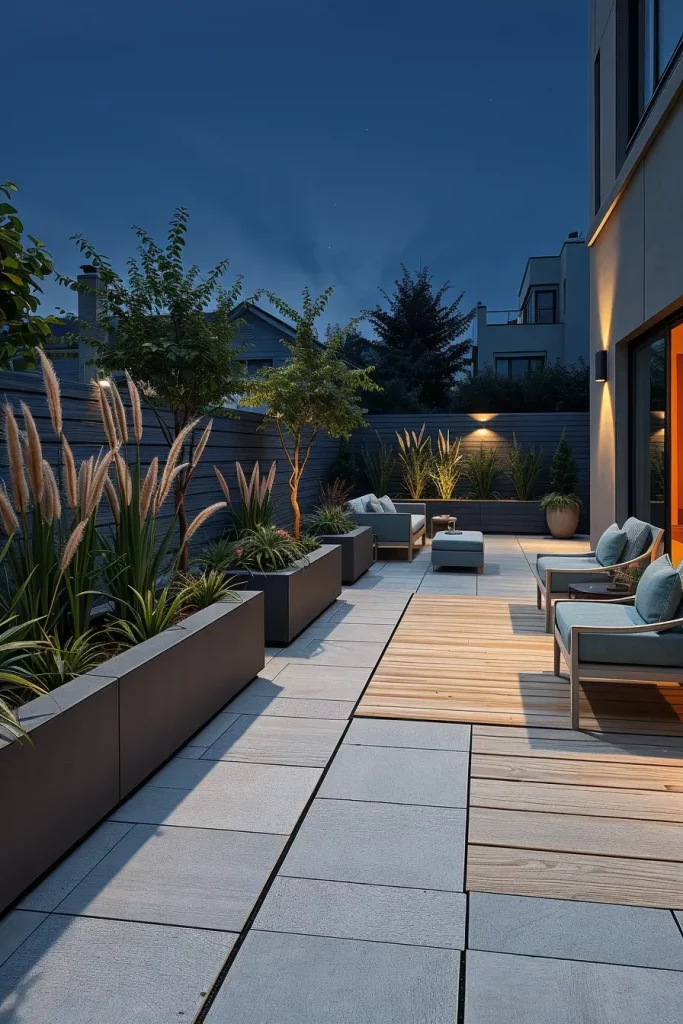
In my designs, I usually recommend long, narrow planters filled with grasses, succulents, or monochromatic floral beds. They line the edges of the terrace and subtly define zones without physical barriers. The sharp gray of the decking, low-profile furniture, and supplemented concrete pavers balance the sight at the terrace’s edge. The intention is calm efficiency and not decoration overload.
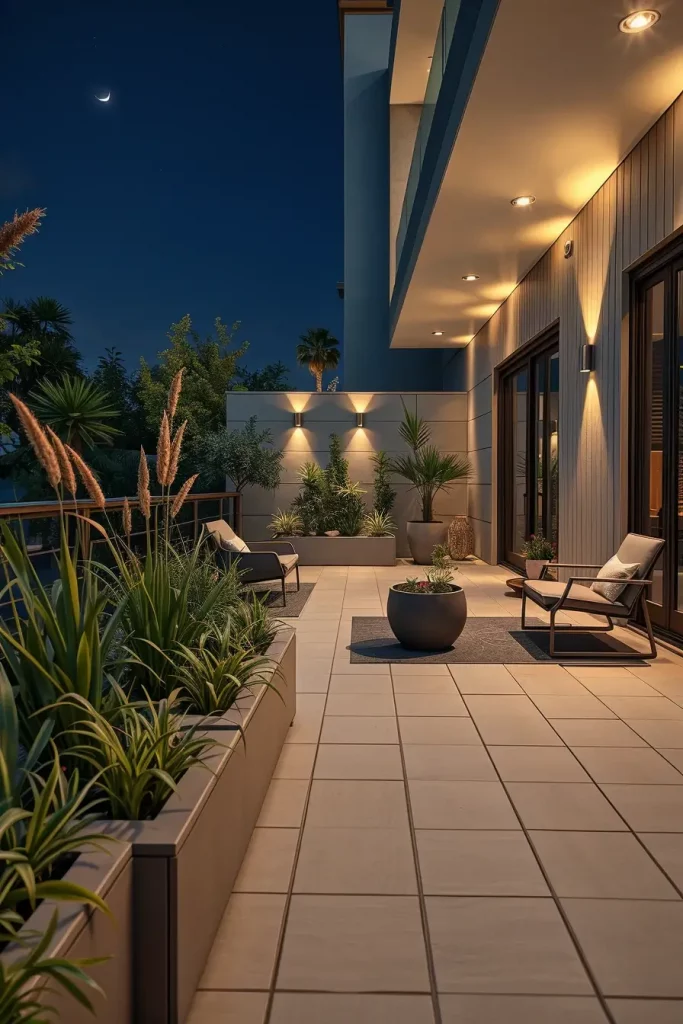
Those living in cities looking for soothing, noise less visuals will appreciate this style. As advised in Dezeen, “Minimalist outdoor spaces should echo the architecture of the home while embracing the serenity of nature.” With the aim to achieve that, I employ rhythmic greenery and clean lines.
If I refine this section further, incorporating architectural lights within the planters will enhance the terrace’s layered visual experience and highlight the greenery at night.
Terraces With Contemporary Vertical Garden Design
Vertical surfaces provide an important range of space for use when horizontal space is limited. With vertical gardens, I am able to transform dull walls into beautiful architectural design elements. This approach is highly functional because it improves air quality, adds privacy, and greenery all without taking up any floor space.
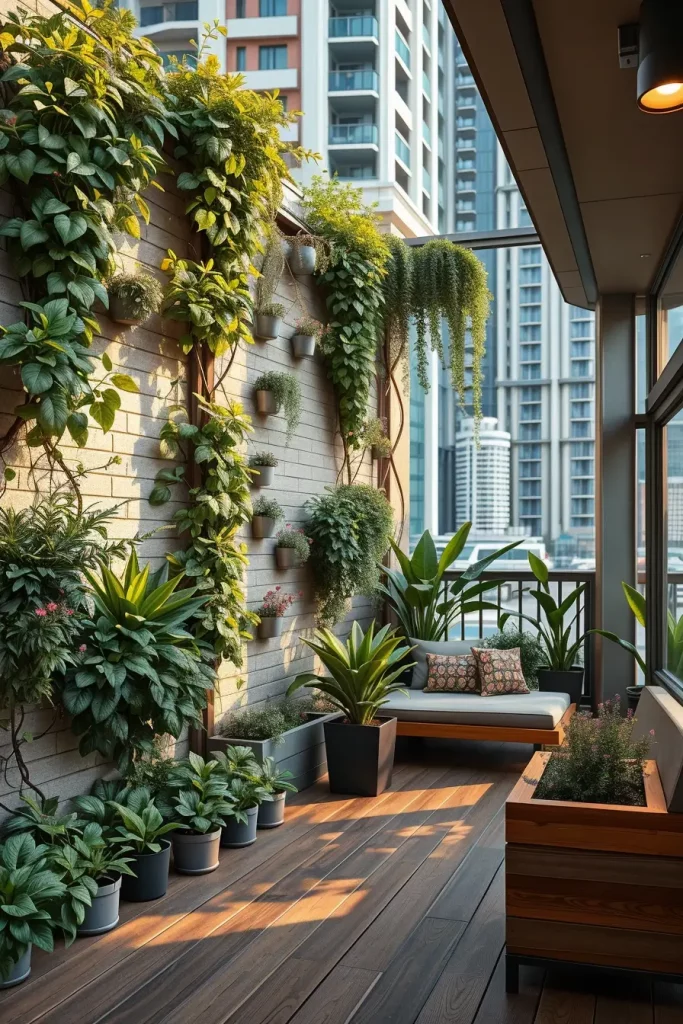
To make modern vertical gardens, I often use modular living wall systems or trellis structures. Ivy, philodendron, and jasmine are ideal climbers, and built-in drip irrigation systems make maintenance easy. Vertical gardens combined with floating benches or sculptural planters transform the wall into a complete design feature.

From personal experience dealing with compact city terraces, I can say that adding these vertical features makes the space feel more immersive and lush. According to Better Homes & Gardens, vertical gardens are one of the most effective methods to add biophilic design elements into urban homes.
To enhance the design, I would suggest incorporating slatted wood, dark metal mesh, or stone veneer as a secondary material behind the greenery to better the overall terrace design and offer contrast.
Sleek Concrete Furniture With Soft Textile Accents
Sleek concrete furniture blends into stylish terrace designs, evolving from an industrial aesthetic. I recommend this to clients seeking sculptural pieces devoid of intricate detailing because they are visually striking, or for those who want bold statement pieces. Modern concrete tables, benches, and loungers have minimal outlines, and their durability allows them to sustain various climates.
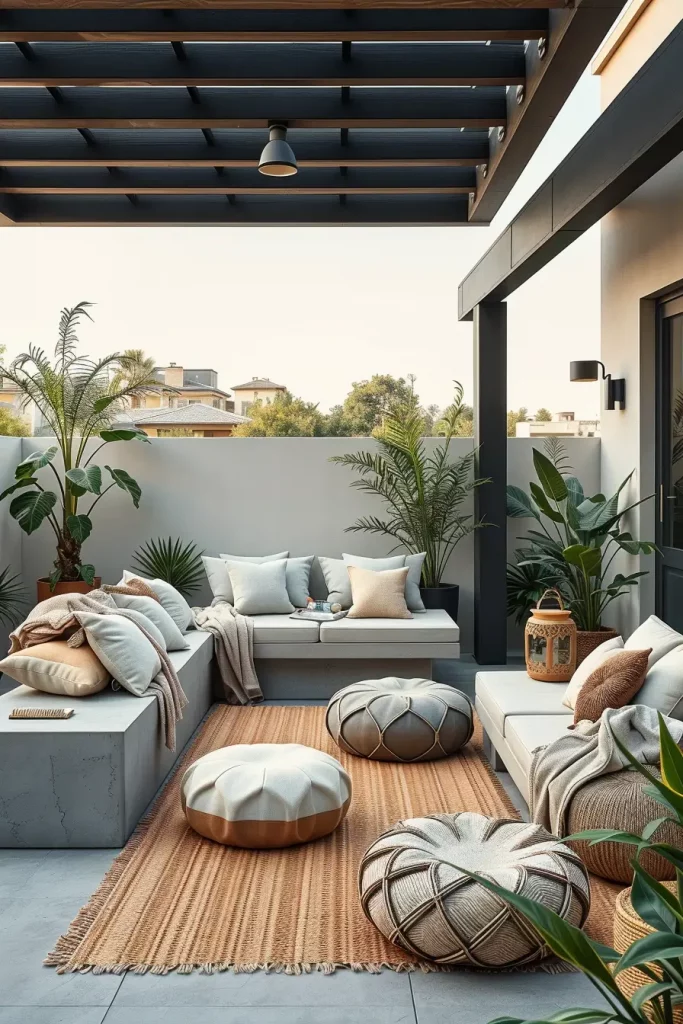
To alleviate the hardness of concrete, soft textile accents are also a must. Cushions, edgy throws, and any outdoor-ready seat cushions are great for adding comfort and for softening the concrete aesthetic. I prefer using polished wood with the concrete, or black powder-coated steel to help bring warmth into the design.
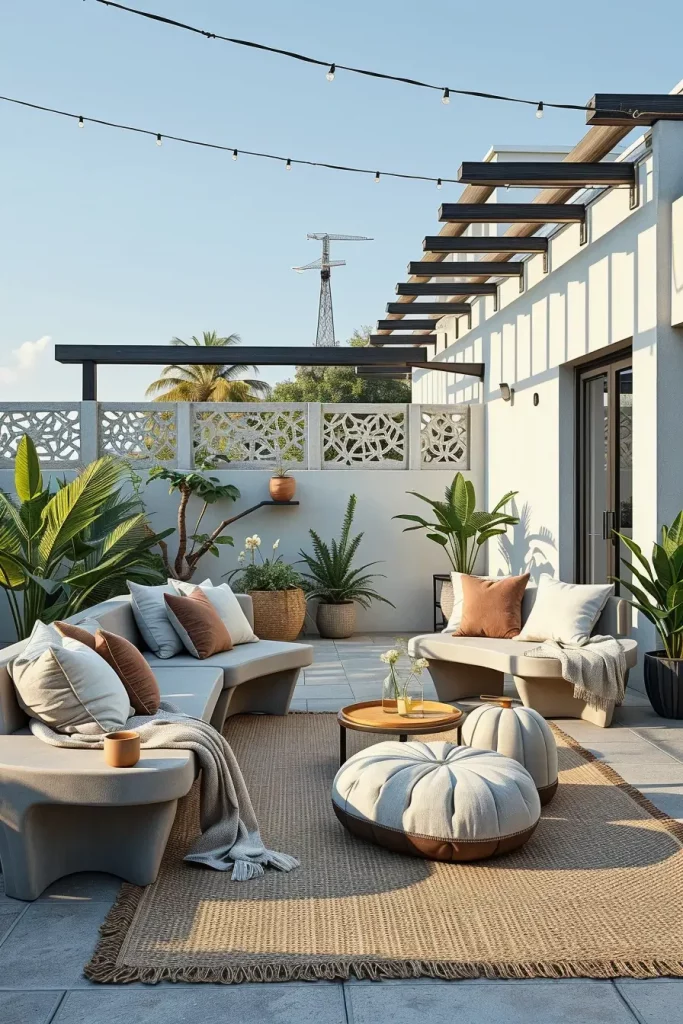
A sculptural concrete bench I paired with soft taupe cushions and linen-draped poufs is subtly raw and refined. Publications like Domino underscore the importance of using softened fabrics with concrete outdoor décor: bold towels and soft cushions will always take the look to new levels.
Vertical heaters with matte black finishes would be a modestly styled seasonal addition to elevate this tease in design, along with woven outdoor rugs placed under the group of furniture.
Slatted Wood Or Metal Statement Ceiling Designs
The lack of attention given to terrace ceilings is quite alarming. However, softwood or metal statement ceilings are attention grabbing and emphasize structure while also giving an intentional sensation of enclosure. Such ceilings can aid in filtering sunlight, providing partial shading, and creating distinct light and shadow contrasts.
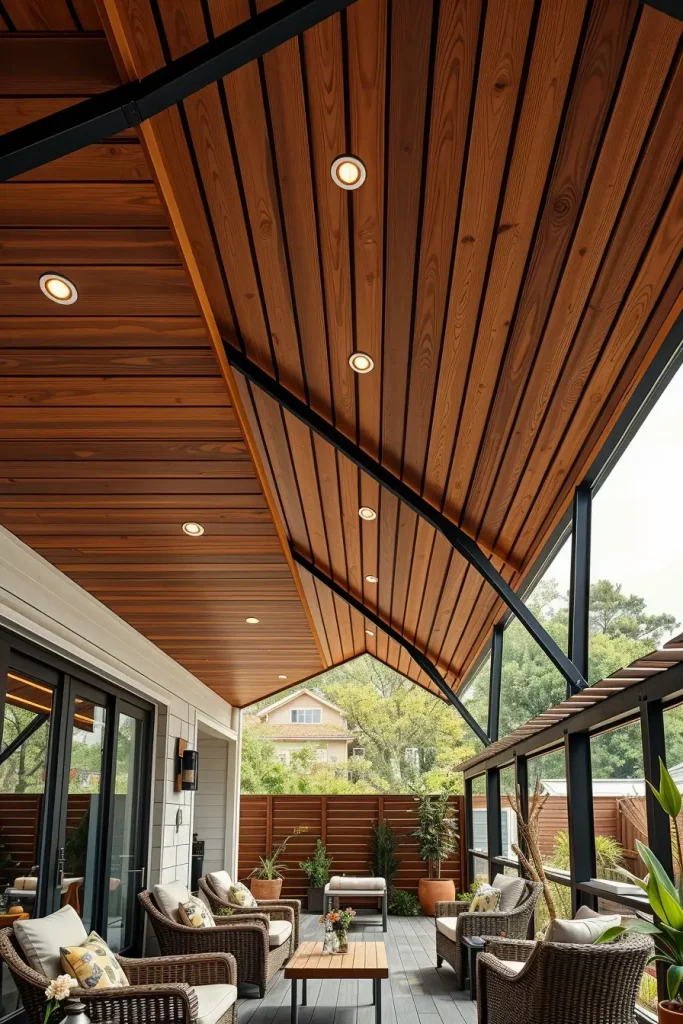
For my designs, I prefer using vertical wood slats in teak, cedar, or even stained pine for that warm feel. If you’re interested in more modern designs, there is perforated metal or geometric pattern powder-coated aluminum which adds an industrial touch. These compliment recessed lights and hanging lanterns.
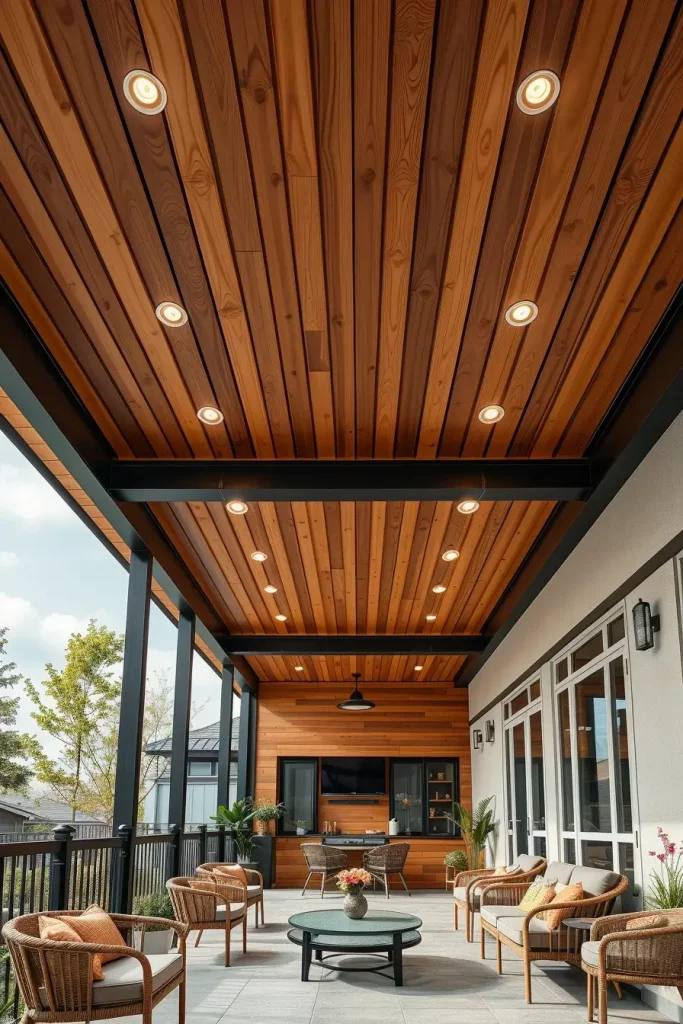
For one of my coastal projects, I designed modern-rustic architecture with cedar slats and matte black steel beams. The transformation was astonishing. It reframed the terrace as the design focus of the home interior and decor. Luxe Interiors + Design notes that well-designed outdoor ceilings integrate features of the home’s structure and nature.
In my professional opinion, adding built-in controls for lighting and shading alongside retractable blinds would deepen the elevation of the experience, allowing for ambient adjustment as well as lighting modification throughout the day.
Modern Terrace Dividers with Frosted Glass
If you’re looking for unobstructive and elegant ways to partition terrace zones, focal glass blocks are the best option. These panels balance privacy and lighting while contributing to a modern design.
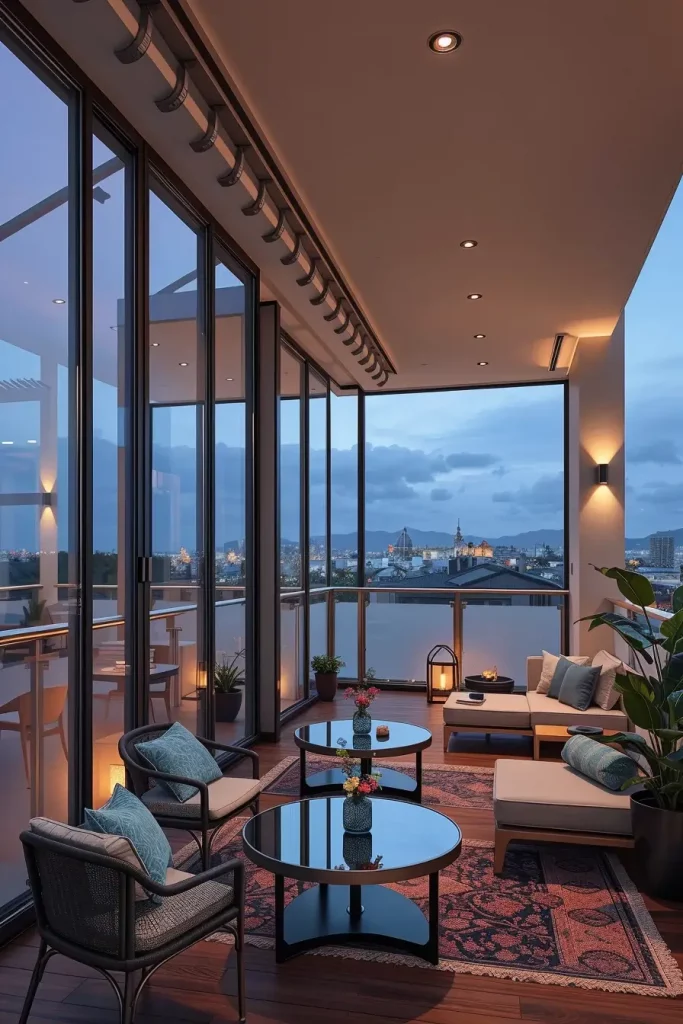
I use either fixed panels framed in narrow aluminum or sliding frosted glass partitions to separate lounging, cooking, or gardening zones. The technique eliminates distraction while diffusing light with minimal obstruction. I have also added some interest into the design with decorative etching and vertical grooves.
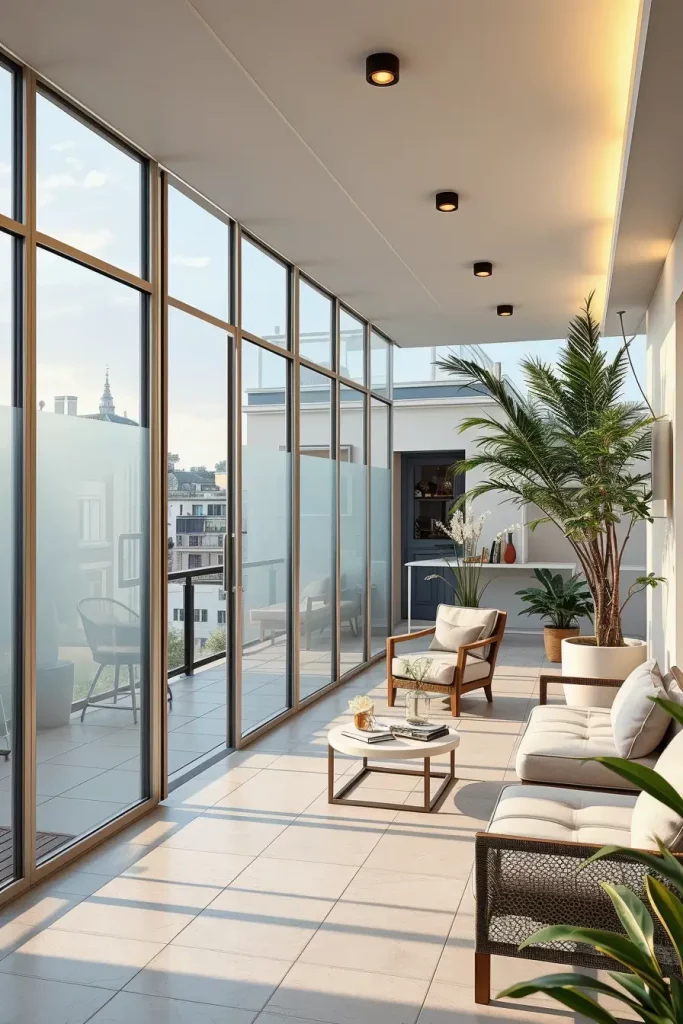
During my most recent rooftop design, I implemented frosted glass walls between the dining area and the outdoor shower. It was pristine, stark and clever at the same time. Reports from magazines like Interior Design Magazine show frost tempered glass features prominently in their indoor-outdoor designs and spatial partitions.
Adding LED edge lighting could further defy the boundaries of character partitioning and framing them with narrow planters would seamlessly integrate nature.
Green Dividers And Integrated Planters
Green dividers and integrated planters facilitate the uncomplicated division of a terrace while maintaining an open, organic feel. Instead of walls, I prefer using layered planting beds or freestanding dividers brimming with shrubs and grasses.
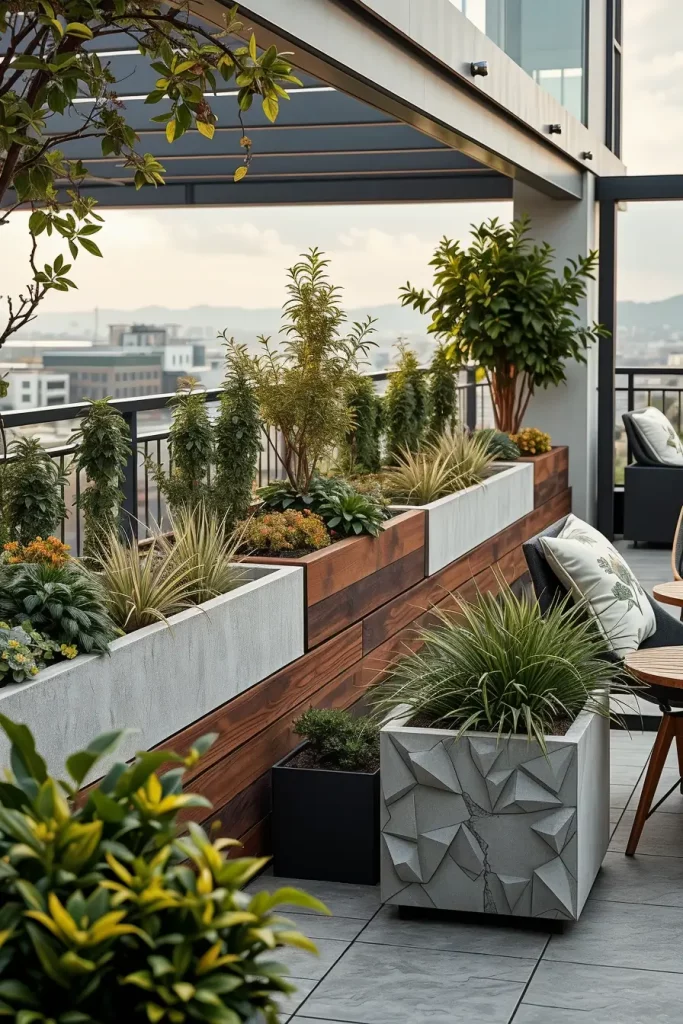
In many cases, these elements serve a double purpose as railings or edge barriers, particularly in rooftop designs. For these planters, I usually design them in the same materials as the terrace flooring or furniture that is around the face. This ensures there is no visual inconsistency. Depending on the design theme, textured concrete, painted wood or rusted corten steel are all good choices.
In my experience, integrated planters do aid in softening drastic modern lines, as well as adding dynamic rhythm to an otherwise flat terrace layout. The Spruce suggest these as integral features to roof top gardens where maximizing green space is a priority.
I’d also make this design more functional by adding seating along the planter sides or lighting under the green dividers to create gentle glow at night.
Distinctive Natural Stone Walls
Adding natural stone walls to a terrace makes the area more fitting for show purposes. Stones help add texture, variation in color and beauty, serving either as a backdrop or as an accent. I often recommend it to my clients who want to make a stark contrast with smoother terrace materials such as metal or glass.
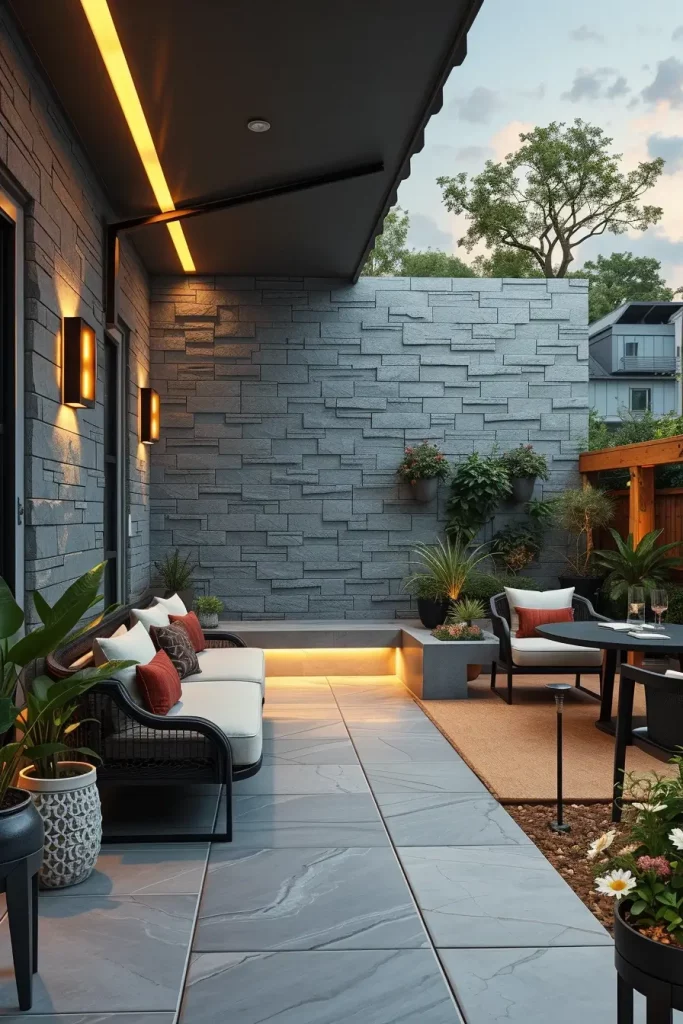
For walls, I usually go for stones like slate or quartzite in warm or earthy hues, depending on the look. With these walls, a floating bench can make the space even more engaging, while coupled with vertical planting or wall-mounted lighting. The surface becomes a living canvas, portraying a fountain of life.
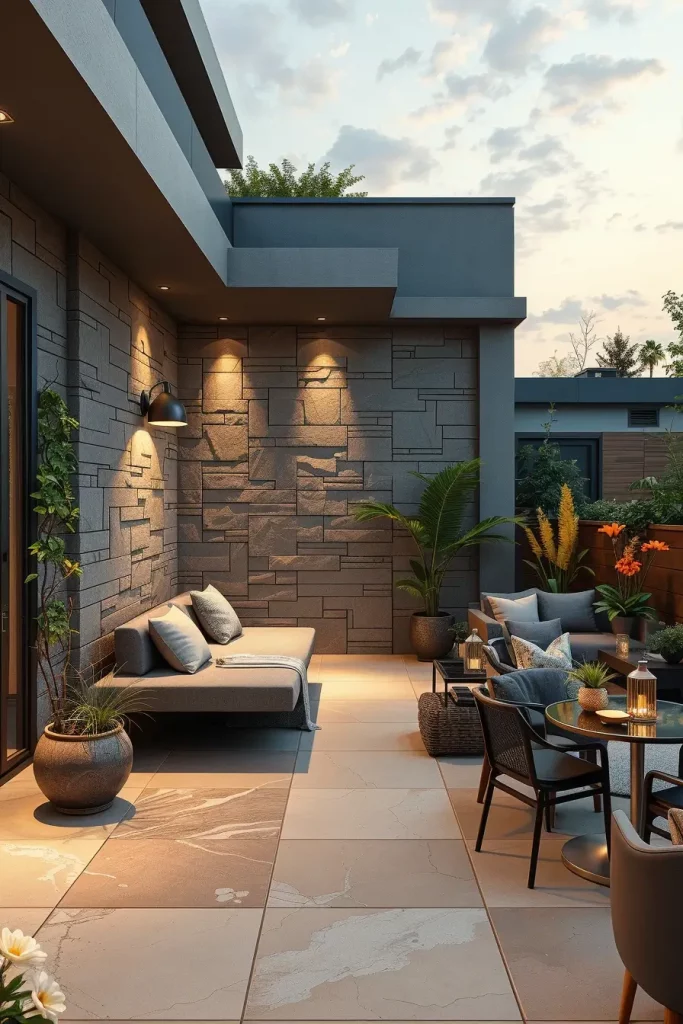
Granite tends to be one of my more favorite stones due to how well a rough-hewn selection pairs with minimalist terrace designs which a lot of my clients usually opt for. According to HGTV, adding wooden elements to the house is one of the best ways to add a luxurious feeling to the outdoor area.
To increase the level of detail in this section, I’d add sculptural mood lighting on the wall or an integrated water feature that draws deeper lines in the design.
Open-Air Terraces With Subtle Coastal Influences
There’s a particular way I approach the design of open-air terraces with coastal elements: decor that captures the essence of lightness and the carefree feeling of a trip to the beach. To reinforce this feeling, terraces often include soothing colors: sandy beige, driftwood grey, soft sky blue, etc. The coast is known for its soothing and serene nature, hence why these colors are incorporated along with free flowing sunlight and ocean wind. With great attention to detail, I make sure that while the design is minimalist, it is calming as well.
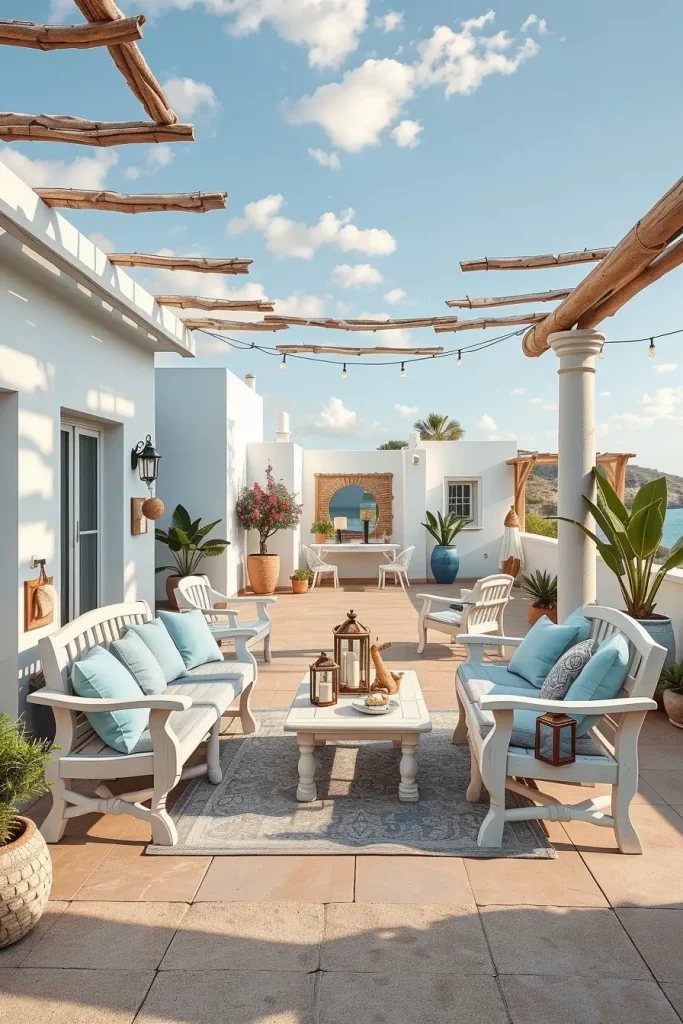
In terms of furniture, a mix of weatherproof teak or whitewashed wood coupled with soft cushions of pale tones is my go-to. Decorative touches like rope lanterns, nautical throw pillows alongside rattan baskets add to the theme while a light blue or white woven rug pulls the whole room together. I cannot emphasize enough the importance of coast friendly materials that can endure harsh salt air and sun, while still lasting long and looking impressive.
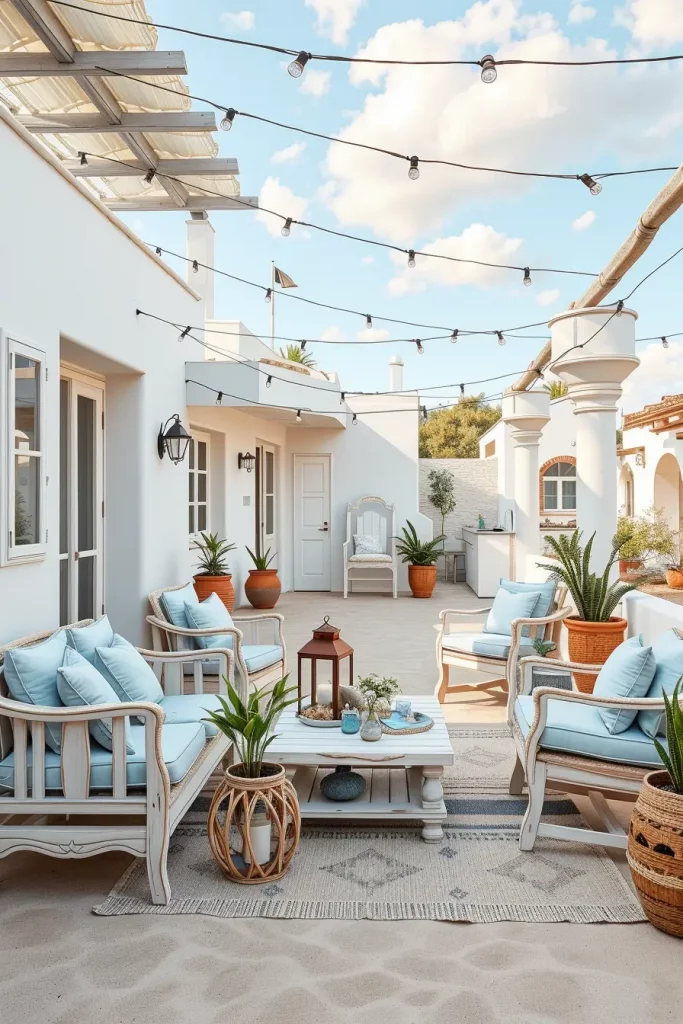
The secret to pulling off this look is, for me at least, great restraint. For instance, don’t overdecorate the space. The term coastal is indicative of inspiration, not a theme. Designers like Nate Berkus are a great source of inspiration, who recommend texture as a way to express style outdoors. A subtle addition of a simple linen shade sail brings grace to the area without overpowering it.
To enhance this part, I would recommend including some foliage, in particular Mediterranean ones like olive trees or lavender in terracotta containers. Aside from complementing the coastline theme, these plants also provide gentle beauty and fragrance.
Designer Symmetry Inspiration in Terrace Layouts
Symmetry remains one of the most powerful design tools I rely on when refining terraces for their finishing touches. They instantly elevate the beautiful, calm feeling of a well-structured space. Designer symmetry has two common variants where all elements revolve around a main feature, an elegant coffee table or an eye-catching fire pit, and repeat it outward. This approach works particularly well for long, narrow terraces, square rooftops, or any shaped contoured space.
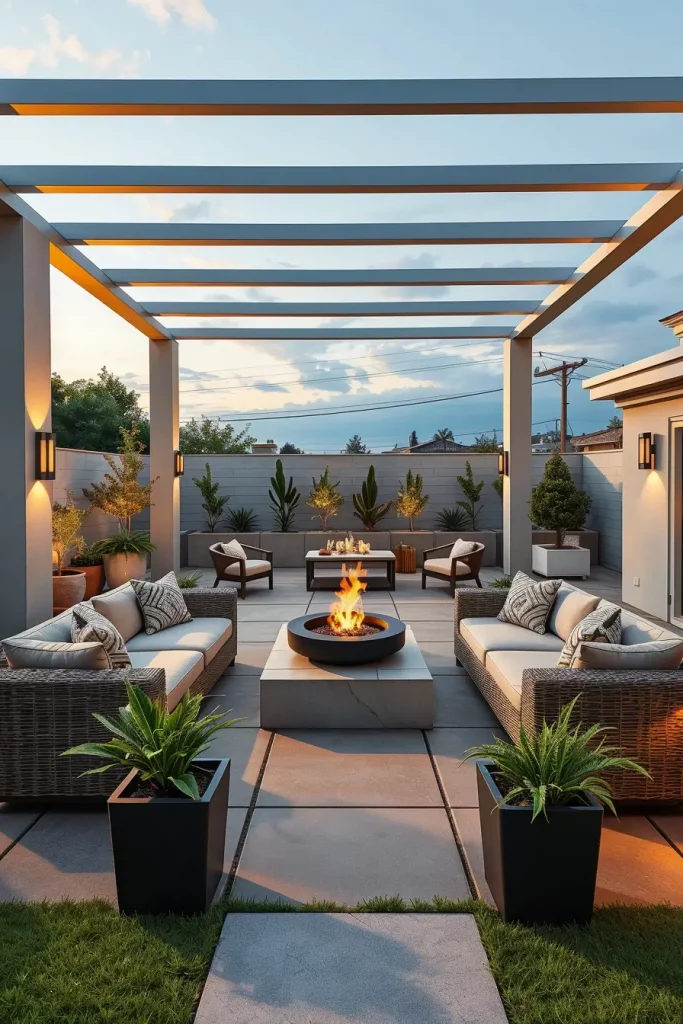
I usually position two identical sofas facing each other with matching side tables and lanterns on each side. To reinforce a symmetrical planter at the corners, a sculptural centerpiece like a low, modern fire bowl vertically anchors the composition. Adaptable elegant or monochrome tones help avoid stifling the space with too much formal structure.
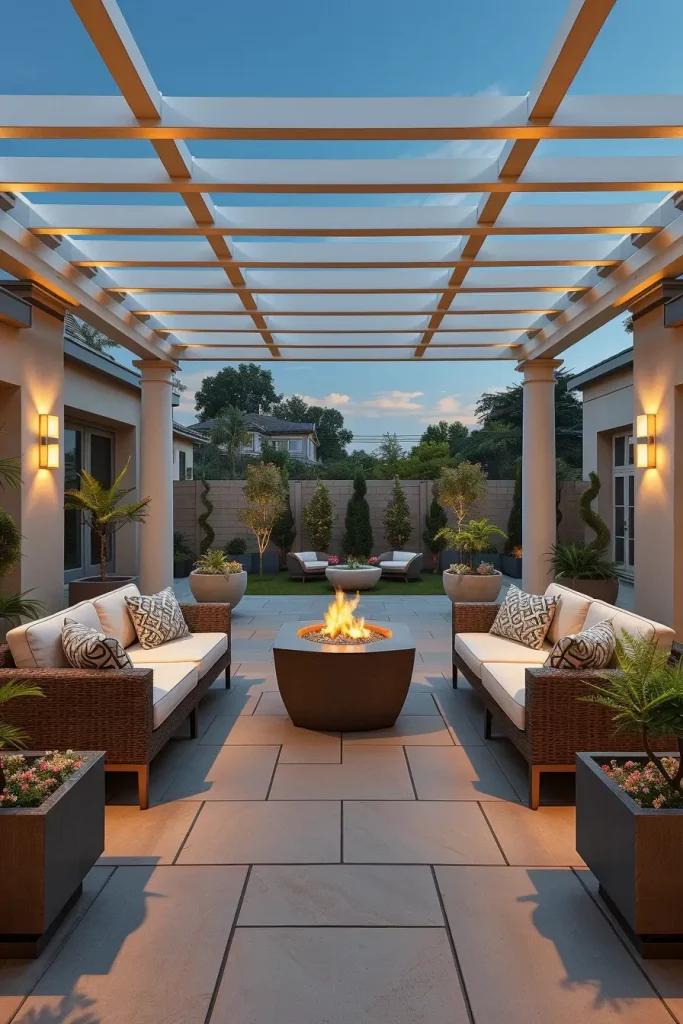
My symmetrical experiences with terraces have revealed they are enjoyable to look at as well as effective in facilitating conversations. Guests look at each other seamlessly, and the balanced structure is both plush and inviting. As has been discussed in Elle Decor, symmetry in outdoor settings has resurfaced in contemporary upscale residential design due to the coziness and nostalgia it brings.
To further develop this thought, I would suggest integrating other subtending elements like a pergola with sheer drapery or decorative flood lighting to enhance the symmetry above and add a sense of enclosure.
Soft Lines And Curved Furniture For Relaxed Flow
Soft lines and curved furniture are my go to when I want a terrace to have a soothing vibe. These factors introduce natural movement to a space by giving relief to the squareness of layouts. This works tremendously well for garden and rooftop terraces where relaxation is the main focus.
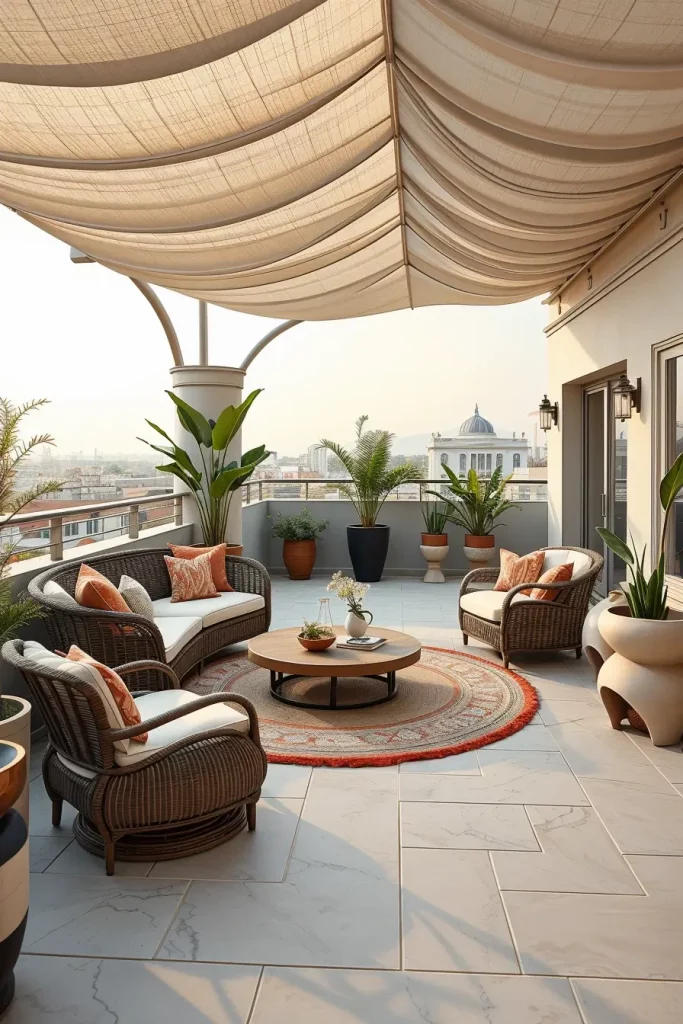
My choice of furniture usually includes rounded coffee tables together with crescent shaped sectionals, and even arched shade canopies. Wicker, boucle fabric and powder coated aluminum are some of the materials in my books that aid softness as well as durability. Along with these, accent elements such as oval rugs, ceramic pots, curved benches and many more which are organically shaped help carry on the visual softness and augment the main seating.
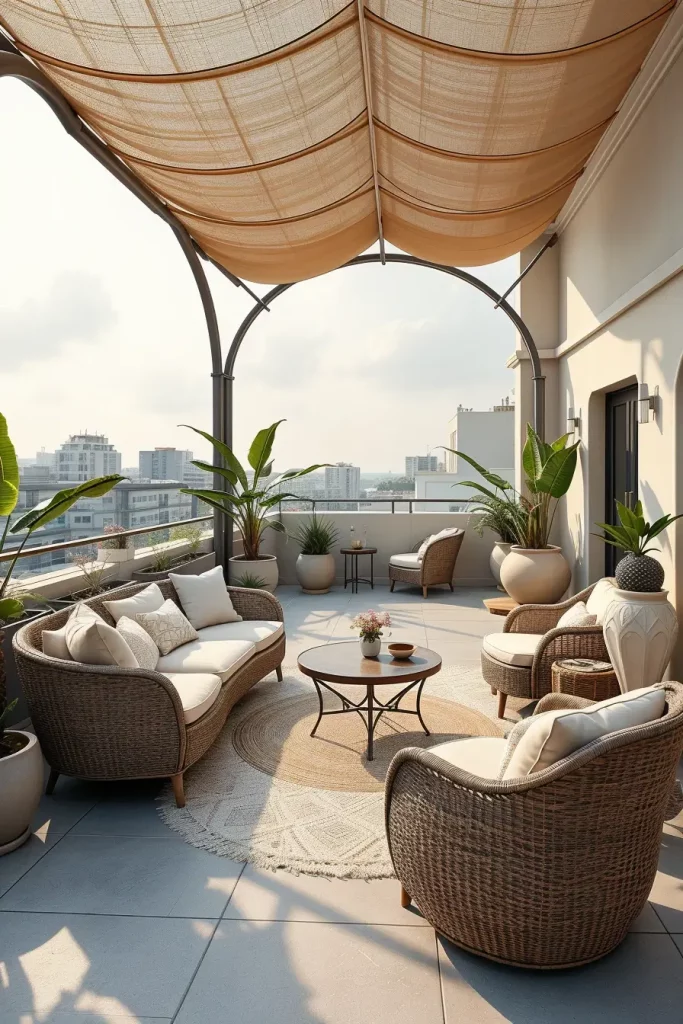
In my experience, spaces with curved walls tend to make people more at ease. I have often noted that people seem to sink deeper and stay longer in these surroundings. Architectural Digest recently noted that curved spatial features in furniture design is linked to comfort and emotional tranquility, especially in a outdoor setting.
If I could add another design element, I would place a water feature such as a small fountain with an arc shape or a minimalist curved basin. The soft sound of the flowing water augments the soothing essence of the design.
Terrace Concepts With Smart Tech And Automation
Incorporated in the design of my modern terraces is the beauty and an artistic touch coupled with highly advanced features. The integration of smart technology while retaining appealing aesthetics transforms the outdoor space into a high-performance extension of house. They include features such as automated lighting, remote controlled shading devices, weather sensors, and even speakers, all operated through a smartphone or voice commands.
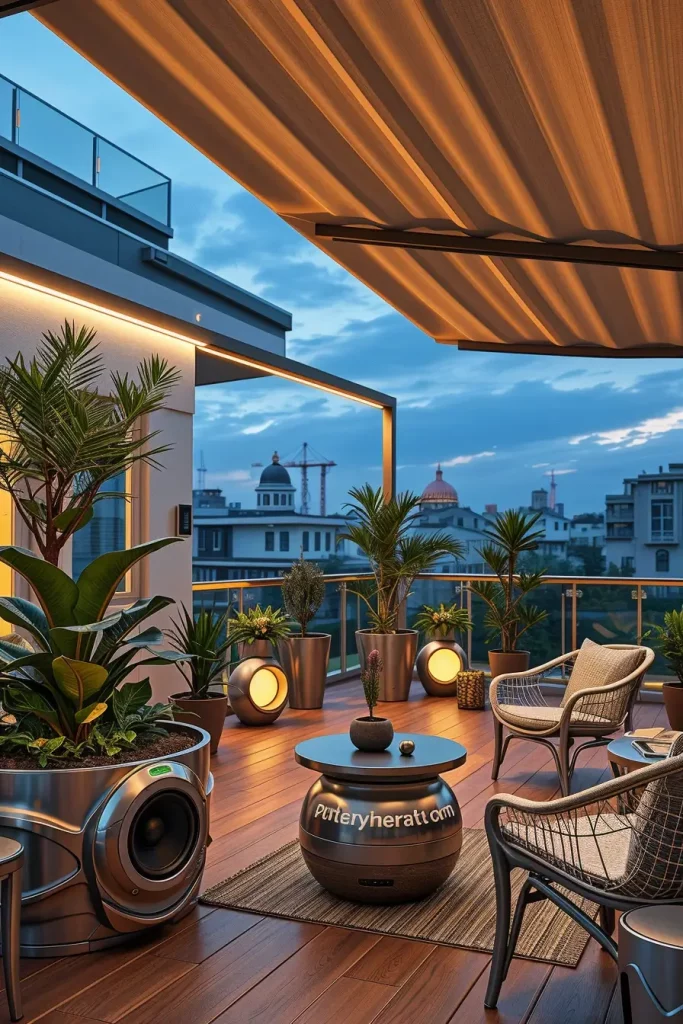
When installing a smart terrace, I usually put dimmable LED strips underneath the seating borders, fog retractable awnings that move with the sun, and planter or furniture-mounted speakers. Smart irrigation systems for potted plants is an equally essential adding to the terrace. These elements not only make the terrace design easier to maintain, but also effortless to keep.
In my experience, using smart automation has totally changed the game when it came to controlling the atmosphere and hosting. During my most recent client installation, we set up motion sensors to enable ambient lighting at sunset and programmed a playlist to welcome guests as they arrived. As I read in Dwell, smart outdoor systems are gaining popularity as driveway and patio access integration become sought after by homeowners wanting technological fluency throughout their domain.
If I had the opportunity to improve on this concept, I would recommend using solar panels for green energy, as well as including an app-operated misting system for summer relaxation.
To achieve a stunning terrace, one needs to combine design, practicality, comfort, and great aesthetics. Whether one prefers minimalist approaches to design, pompous materials, construction engineering features, or sleek integrated technology, it truly matters how one achieves creativity with authenticity. I want to know what your creations would look like—what would you include in your dream terrace design? Let me know your suggestions or questions in the comments below.
